
EXAR Corporation 48720 Kato Road, Fremont CA, 94538 � (510) 668-7000 � FAX (510) 668-7017 � www.exar.com � uarttechsupport@exar.com
��
��
��
��
XR16C2850
3.3V AND 5V DUART WITH 128-BYTE FIFO
APRIL 2002
REV. 2.0.0
GENERAL DESCRIPTION
The XR16C2850
1
(2850) is an enhanced dual univer-
sal asynchronous receiver and transmitter (UART).
Enhanced features include 128 bytes of TX and RX
FIFOs, programmable TX and RX FIFO trigger level,
FIFO level counters, automatic (RTS/CTS) hardware
and (Xon/Xoff) software flow control, automatic RS-
485 half duplex direction control output and data rates
up to 6.25 Mbps at 5V and 8X sampling clock. On-
board status registers provide the user with opera-
tional status and data error flags. An internal loop-
back capability allows system diagnostics. The 2850
has a full modem interface and can operate at 3.3 V
or 5 V and is pin-to-pin compatible to Exar's
ST16C2550 and XR16C2750 except the 48-TQFP
package. The 2850 register set is compatible to the
industry standard ST16C2550 and is available in 48-
pin TQFP, 44-pin PLCC and 40-pin PDIP packages.
The 40-pin package does not offer TXRDY# and
RXRDY# pins (DMA signal monitoring) otherwise the
three package versions are the same.
N
OTE
:
1 Covered by U.S. Patent #5,649,122 and #5,832,205
APPLICATIONS
� Portable Appliances
� Telecommunication Network Routers
� Ethernet Network Routers
� Cellular Data Devices
� Factory Automation and Process Controls
FEATURES
� Pin-to-pin compatible and functionally compatible to
Exar's ST16C2550 and XR16L2750 and TI's
TL16C752B on the 44-PLCC package
� Pin-alike Exar's XR16L2750 and ST16C2550 48-
TQFP package but with additional CLK8/16, CLK-
SEL and HDCNTL inputs
� Two independent UART channels
� Register set compatible to 16C550
� Up to 6.25 Mbps at 5V, and 4 Mbps at 3.3V
� Transmit and Receive FIFOs of 128 bytes
� Programmable TX and RX FIFO Trigger Levels
� Transmit and Receive FIFO Level Counters
� Automatic Hardware (RTS/CTS) Flow Control
� Selectable Auto RTS Flow Control Hysteresis
� Automatic Software (Xon/Xoff) Flow Control
� Automatic RS-485 Half-duplex Direction Control
Output
� Wireless Infrared (IrDA 1.0) Encoder/Decoder
� Automatic sleep mode
� Full modem interface
� Device Identification and Revision
� Crystal oscillator or external clock input
� Industrial and commercial temperature ranges
� 48-TQFP and 44-PLCC packages
F
IGURE
1. XR16C2850 B
LOCK
D
IAGRAM
XTAL1
XTAL2
Crystal Osc/Buffer
TXA, RXA, DTRA#,
DSRA#, RTSA#,
DTSA#, CDA#, RIA#,
OP2A#
8-bit Data
Bus
Interface
UART Channel A
128 Byte TX FIFO
128 Byte RX FIFO
BRG
IR
ENDEC
TX & RX
UART
Regs
3.3V or 5V VCC
GND
TXB, RXB, DTRB#,
DSRB#, RTSB#,
CTSB#, CDB#, RIB#,
OP2B#
UART Channel B
(same as Channel A)
A2:A0
D7:D0
CSA#
CSB#
INTA
INTB
IOW#
IOR#
Reset
TXRDYA#
TXRDYB#
RXRDYA#
RXRDYB#
CLK8/16
CLKSEL
HDCNTL#

��
��
��
��
3.3V AND 5V DUART WITH 128-BYTE FIFO
XR16C2850
REV. 2.0.0
2
F
IGURE
2. P
IN
O
UT
A
SSIGNMENT
48
47
46
45
44
43
42
41
40
39
38
37
1
2
3
4
5
6
7
8
9
10
11
12
36
35
34
33
32
31
30
29
28
27
26
25
13
14
15
16
17
18
19
20
21
22
23
24
D5
D6
D7
RXB
RXA
TXRDYB#
TXA
TXB
OP2B#
CSA#
CSB#
NC
XT
AL
1
XT
AL
2
IO
W
#
CD
B
#
GN
D
RX
RD
Y
B
#
IO
R
#
DS
RB
#
RI
B
#
R
T
SB#
C
T
SB#
CL
K
8
/
1
6
RESET
DTRB#
DTRA#
RTSA#
OP2A#
RXRDYA#
INTA
INTB
A0
A1
A2
CLKSEL
D4
D3
D2
D1
D0
T
X
R
D
YA
#
VC
C
RI
A
#
CD
A
#
DS
RA
#
C
T
SA#
HD
CNT
L
#
XR16C2850
48-pin TQFP
6
5
4
3
2
1
44
43
42
41
40
7
8
9
10
11
12
13
14
15
16
17
39
38
37
36
35
34
33
32
31
30
29
18
19
20
21
22
23
24
25
26
27
28
D5
D6
D7
RXB
RXA
TXRDYB#
TXA
TXB
OP2B#
CSA#
CSB#
RESET
DTRB#
DTRA#
RTSA#
OP2A#
RXRDYA#
INTA
INTB
A0
A1
A2
XT
AL
1
XT
AL
2
IO
W
#
CDB
#
GN
D
RX
RD
Y
B
#
IO
R
#
DS
RB
#
RI
B
#
R
T
SB#
C
T
SB#
D4
D3
D2
D1
D0
TX
RDY
A
#
VC
C
RI
A
#
CDA
#
DS
RA
#
C
T
SA#
XR16C2850
44-pin PLCC
1
2
3
4
5
6
7
8
9
10
11
12
13
14
15
16
17
18
19
20
40
39
38
37
36
35
34
33
32
31
30
29
28
27
26
25
24
23
22
21
D0
D1
D2
D3
D4
D5
D6
D7
RXB
RXA
TXA
TXB
OP2B#
CSA#
CSB#
XTAL1
XTAL2
IOW#
CDB#
GND
VCC
RIA#
CDA#
DSRA#
CTSA#
RESET
DTRB#
DTRA#
RTSA#
OP2A#
INTA
INTB
A0
A1
A2
CTSB#
RTSB#
RIB#
DSRB#
IOR#
XR
16C
2850
4
0
-
pin PD
I
P
ORDERING INFORMATION
P
ART
N
UMBER
(C
OMMERCIAL
)
P
ACKAGE
O
PERATING
T
EMPERATURE
R
ANGE
P
ART
N
UMBER
(I
NDUSTRIAL
)
P
ACKAGE
O
PERATING
T
EMPERATURE
R
ANGE
XR16C2850CP40
40-PDIP
0�C to +70�C
XR16C2850IP40
40-PDIP
-40�C to +85�C
XR16C2850CJ44
44-PLCC
0�C to +70�C
XR16C2850IJ44
44-PLCC
-40�C to +85�C
XR16C2850CM48
48-TQFP
0�C to +70�C
XR16C2850IM48
48-TQFP
-40�C to +85�C
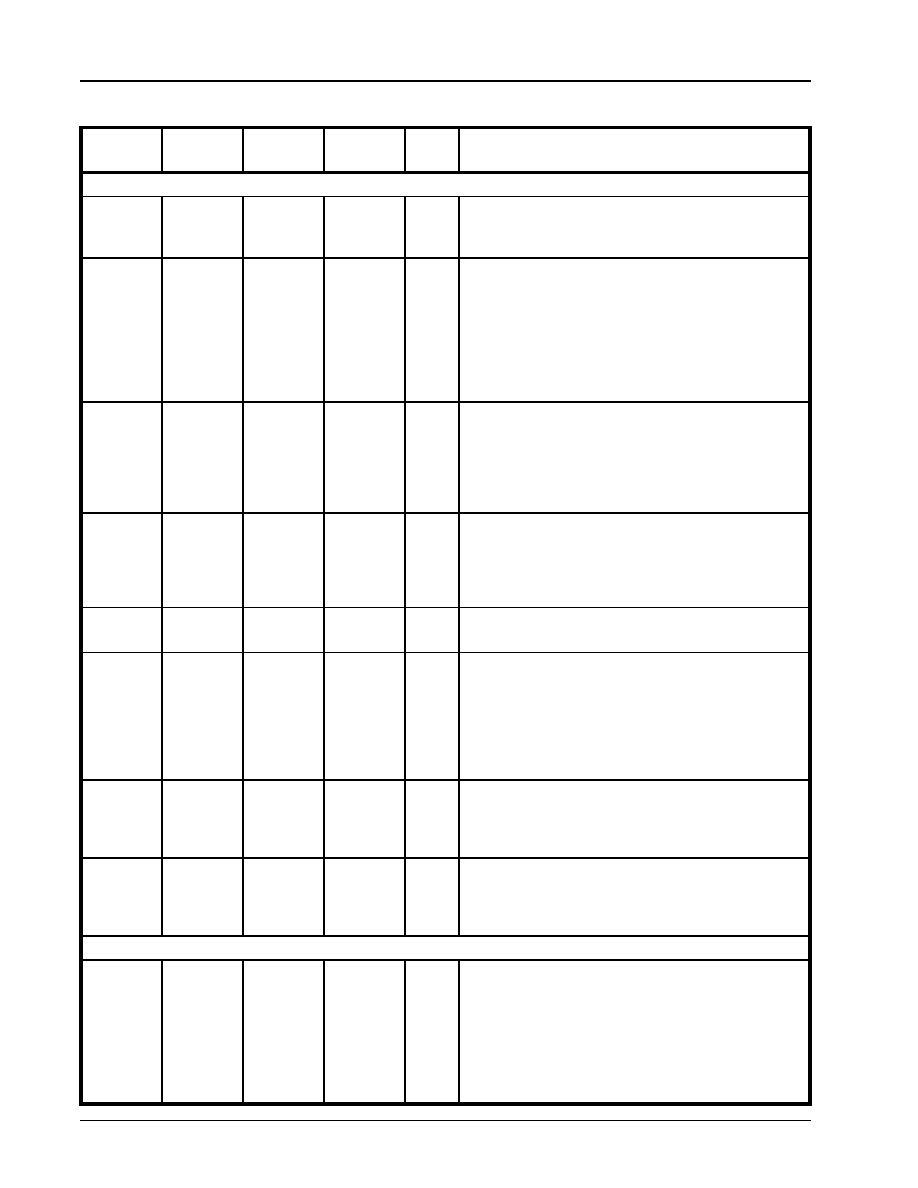
XR16C2850
3.3V AND 5V DUART WITH 128-BYTE FIFO
��
��
��
��
REV. 2.0.0
3
PIN DESCRIPTIONS
N
AME
40-PDIP
P
IN
#
44-PLCC
P
IN
#
48-TQFP
P
IN
#
T
YPE
D
ESCRIPTION
DATA BUS INTERFACE
A2
A1
A0
26
27
28
29
30
31
26
27
28
I
Address data lines [2:0]. These 3 address lines select
one of the internal registers in UART channel A/B during
a data bus transaction.
D7
D6
D5
D4
D3
D2
D1
D0
8
7
6
5
4
3
2
1
9
8
7
6
5
4
3
2
3
2
1
48
47
46
45
44
I/O
Data bus lines [7:0] (bidirectional).
IOR#
21
24
19
I
Input/Output Read Strobe (active low). The falling edge
instigates an internal read cycle and retrieves the data
byte from an internal register pointed to by the address
lines A2:A0. The data byte is placed on the data bus to
allow the host processor to read it on the rising edge.
IOR# must never be active together with IOW#.
IOW#
18
20
15
I
Input/Output Write Strobe (active low). The falling edge
instigates an internal write cycle and the rising edge
transfers the data byte on the data bus to an internal reg-
ister pointed by the address lines. IOW# must never be
active together with IOR#.
CSA#
CSB#
14
15
16
17
10
11
I
UART channel select (active low) to enable UART chan-
nel A or B in the device for data bus operation.
INTA
INTB
30
29
33
32
30
29
O
UART channel A or B Interrupt output. The output state is
defined by the user through the software setting of
MCR[3]. INTA or INTB is set to the active mode and
OP2A# or OP2B# output to a logic 0 when MCR[3] is set
to a logic 1. INTA or INTB is set to the three state mode
and OP2A# or OP2B# to a logic 1 when MCR[3] is set to
a logic 0 (default). See MCR[3].
TXRDYA#
TXRDYB#
-
-
1
12
43
6
O
UART channel A or B Transmitter Ready (active low).
The output provides the TX FIFO/THR status for transmit
channel A or B. See Table 2 on page 8. If it is not used,
leave it unconnected.
RXRDYA#
RXRDYB#
-
-
34
23
31
18
O
UART channel A or B Receiver Ready (active low). This
output provides the RX FIFO/RHR status for receive
channel A or B. See Table 2 on page 8. If it is not used,
leave it unconnected.
MODEM OR SERIAL I/O INTERFACE
TXA
TXB
11
12
13
14
7
8
O
UART channel A or B Transmit Data or infrared encoder
data. Standard transmit and receive interface is enabled
when MCR[6] = 0. In this mode, the TX signal will be a
logic 1 during reset or idle (no data). Infrared IrDA trans-
mit and receive interface is enabled when MCR[6] = 1. In
the Infrared mode, the inactive state (no data) for the
Infrared encoder/decoder interface is a logic 0. If it is not
used, leave it unconnected.

��
��
��
��
3.3V AND 5V DUART WITH 128-BYTE FIFO
XR16C2850
REV. 2.0.0
4
RXA
RXB
10
9
11
10
5
4
I
UART channel A Receive Data or infrared receive data.
Normal receive data input must idle at logic 1 condition.
The infrared receiver pulses typically idles at logic 0 but
can be inverted by software control prior going in to the
decoder, see MCR[6] and FCTR[2]. If this pin is not used,
tie it to VCC or pull it high via a 100k ohm resistor.
RTSA#
RTSB#
32
24
36
27
33
22
O
UART channel A or B Request-to-Send (active low) or
general purpose output. This output must be asserted
prior to using auto RTS flow control, see EFR[6], MCR[1],
FCTR[1:0], EMSR[5:4] and IER[6].
CTSA#
CTSB#
36
25
40
28
38
23
I
UART channel A or B Clear-to-Send (active low) or gen-
eral purpose input. It can be used for auto CTS flow con-
trol, see EFR[7], and IER[7]. This input should be
connected to VCC when not used.
DTRA#
DTRB#
33
34
37
38
34
35
O
UART channel A or B Data-Terminal-Ready (active low)
or general purpose output. If it is not used, leave it uncon-
nected.
DSRA#
DSRB#
37
22
41
25
39
20
I
UART channel A or B Data-Set-Ready (active low) or
general purpose input. This input should be connected to
VCC when not used. This input has no effect on the
UART.
CDA#
CDB#
38
19
42
21
40
16
I
UART channel A or B Carrier-Detect (active low) or gen-
eral purpose input. This input should be connected to
VCC when not used. This input has no effect on the
UART.
RIA#
RIB#
39
23
43
26
41
21
I
UART channel A or B Ring-Indicator (active low) or gen-
eral purpose input. This input should be connected to
VCC when not used. This input has no effect on the
UART.
OP2A#
OP2B#
31
13
35
15
32
9
O
Output Port 2 channel A or B - The output state is defined
by the user and through the software setting of MCR[3].
INTA or INTB is set to the active mode and OP2A# or
OP2B# output to a logic 0 when MCR[3] is set to a logic
1. INTA or INTB is set to the three state mode and OP2A#
or OP2B# to a logic 1 when MCR[3] is set to a logic 0.
See MCR[3]. This output should not be used as a general
output else it will disturb the INTA or INTB output function-
ality.
ANCILLARY SIGNALS
XTAL1
16
18
13
I
Crystal or external clock input.
XTAL2
17
19
14
O
Crystal or buffered clock output.
HDCNTL#
-
-
37
I
RS-485 half duplex directional control for channel A and B
(active low). Connect to VCC for normal RTS# function
and connect to GND for RS-485 half duplex direction con-
trol. RTS# pin goes low for transmit and high for receive.
This pin is wire "OR-ed" with FCTR[3]. See FCTR[3].
N
AME
40-PDIP
P
IN
#
44-PLCC
P
IN
#
48-TQFP
P
IN
#
T
YPE
D
ESCRIPTION
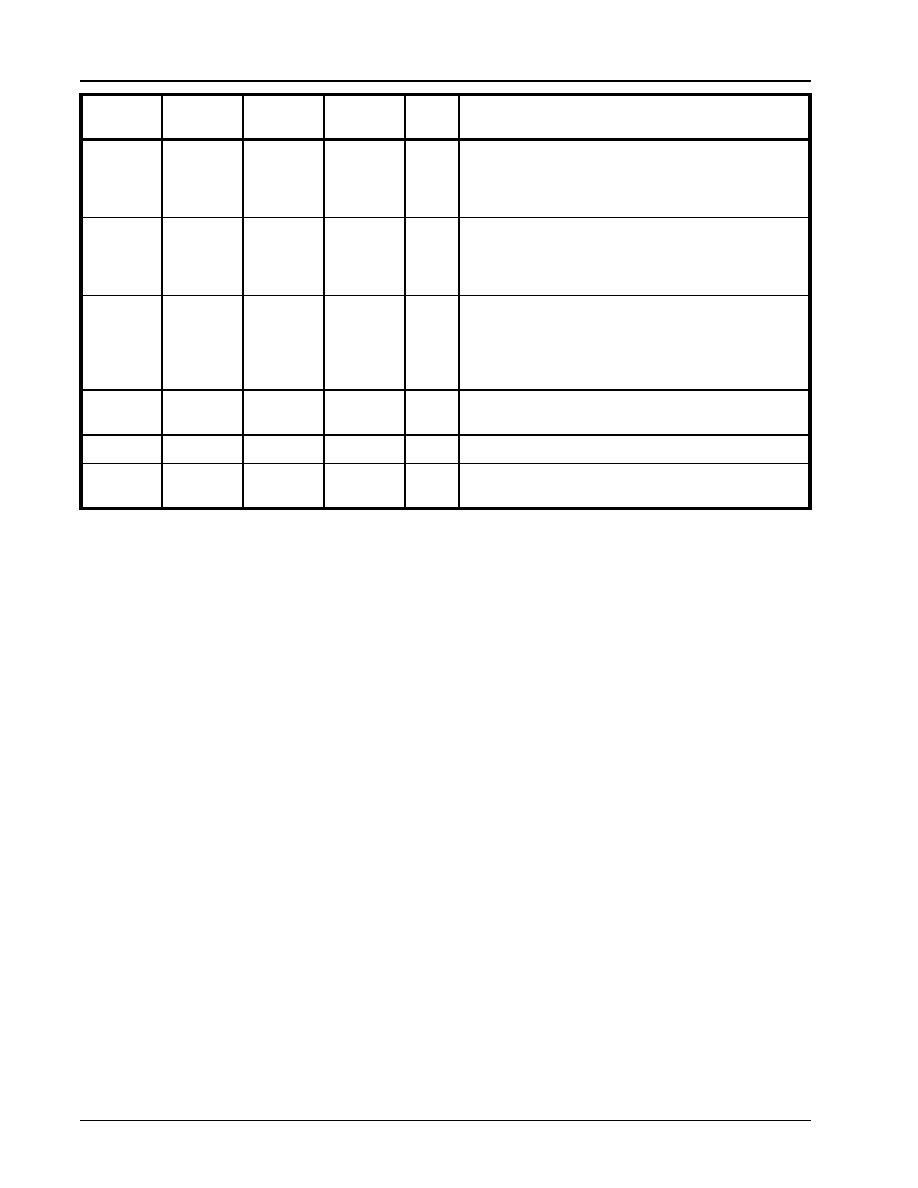
XR16C2850
3.3V AND 5V DUART WITH 128-BYTE FIFO
��
��
��
��
REV. 2.0.0
5
Pin type: I=Input, O=Output, I/O= Input/output, OD=Output Open Drain.
CLKSEL
-
-
25
I
Clock Pre-scaler select. Connect to VCC for divide by 1
(default) and GND for divide by 4. MCR[7] can override
the state of this pin following reset or initialization. See
Figure 6 and MCR[7].
CLK8/16
-
-
24
I
Transmit/Receive data sampling rate. Connect to VCC for
normal 16X sampling clock (standard baud rates, default)
or GND for 8X sampling clock to double the standard
baud rates, 2X.
RESET
35
39
36
I
Reset (active high) - A longer than 40 ns logic 1 pulse on
this pin will reset the internal registers and all outputs.
The UART transmitter output will be held at logic 1, the
receiver input will be ignored and outputs are reset during
reset period (see External Reset Conditions).
VCC
40
44
42
Pwr
3.3V or 5V power supply. Please note that the inputs are
not 5V tolerant when operating at 3.3V.
GND
20
22
17
Pwr
Power supply common, ground.
N.C.
none
none
12
No Connection. These pins are open, but typically, should
be connected to GND for good design practice.
N
AME
40-PDIP
P
IN
#
44-PLCC
P
IN
#
48-TQFP
P
IN
#
T
YPE
D
ESCRIPTION

��
��
��
��
3.3V AND 5V DUART WITH 128-BYTE FIFO
XR16C2850
REV. 2.0.0
6
1.0
PRODUCT DESCRIPTION
The XR16C2850 (2850) integrates the functions of 2
enhanced 16C550 Universal Asynchrounous Receiv-
er and Transmitter (UART). Each UART is indepen-
dently controlled having its own set of device configu-
ration registers. The configuration registers set is
16550 UART compatible for control, status and data
transfer. Additionally, each UART channel has 128-
bytes of transmit and receive FIFOs, automatic RTS/
CTS hardware flow control with hysteresis control,
automatic Xon/Xoff and special character software
flow control, programmable transmit and receive
FIFO trigger levels, FIFO level counters, infrared en-
coder and decoder (IrDA ver 1.0), programmable
baud rate generator with a prescaler of divide by 1 or
4, and data rate up to 6.25 Mbps with 8X sampling
clock rate or 3.125Mbps in the 16X rate. The
XR16C2850 is a 5V and 3.3V device. The 2850 is
fabricated with an advanced CMOS process.
Enhanced Features
The 2850 DUART provides a solution that supports
128 bytes of transmit and receive FIFO memory, in-
stead of 64 bytes provided in the XR16L2750 and 16
bytes in the ST16C2550, or one byte in the
ST16C2450. The 2850 is designed to work with high
performance data communication systems, that re-
quire fast data processing time. Increased perfor-
mance is realized in the 2850 by the larger transmit
and receive FIFOs, FIFO trigger level control, FIFO
level counters and automatic flow control mecha-
nism. This allows the external processor to handle
more networking tasks within a given time. For exam-
ple, the ST16C2550 with a 16 byte FIFO, unloads 16
bytes of receive data in 1.53 ms (This example uses a
character length of 11 bits, including start/stop bits at
115.2Kbps). This means the external CPU will have
to service the receive FIFO at 1.53 ms intervals. How-
ever with the 128 byte FIFO in the 2850, the data
buffer will not require unloading/loading for 12.2 ms.
This increases the service interval giving the external
CPU additional time for other applications and reduc-
ing the overall UART interrupt servicing time. In addi-
tion, the programmable FIFO level trigger interrupt
and automatic hardware/software flow control is
uniquely provided for maximum data throughput per-
formance especially when operating in a multi-chan-
nel system. The combination of the above greatly re-
duces the CPU's bandwidth requirement, increases
performance, and reduces power consumption.
The 2850 supports a half-duplex output direction con-
trol signaling pin, RTS# A/B, to enable and disable
the external RS-485 transceiver operation. It auto-
matically switches the logic state of the output pin to
the receive state after the last stop-bit of the last char-
acter has been shifted out of the transmitter. After re-
ceiving, the logic state of the output pin switches back
to the transmit state when a data byte is loaded in the
transmitter. The auto RS-485 direction control pin is
not activated after reset. To activate the direction con-
trol function, user has to set FCTR Bit-3 to "1". This
pin is normally high for receive state, low for transmit
state.
Data Rate
The 2850 is capable of operation up to 3.125Mbps at
5V with 16x internal sampling clock rate, and
6.25Mbps at 5V with 8x sampling clock rate (available
only on the 48-pin package). The device can operate
with an external 24 MHz crystal on pins XTAL1 and
XTAL2, or external clock source of up to 50 MHz on
XTAL1 pin. With a typical crystal of 14.7464 MHz and
through a software option, the user can set the pres-
caler bit for data rates of up to 1.84Mbps.
The rich feature set of the 2850 is available through
the internal registers. Automatic hardware/software
flow control, selectable transmit and receive FIFO
trigger levels, selectable TX and RX baud rates, infra-
red encoder/decoder interface, modem interface con-
trols, and a sleep mode are all standard features.
Following a power on reset or an external reset, the
2850 is software compatible with previous generation
of UARTs, 16C450, 16C550 and 16C650Aas well as
the 16C850.
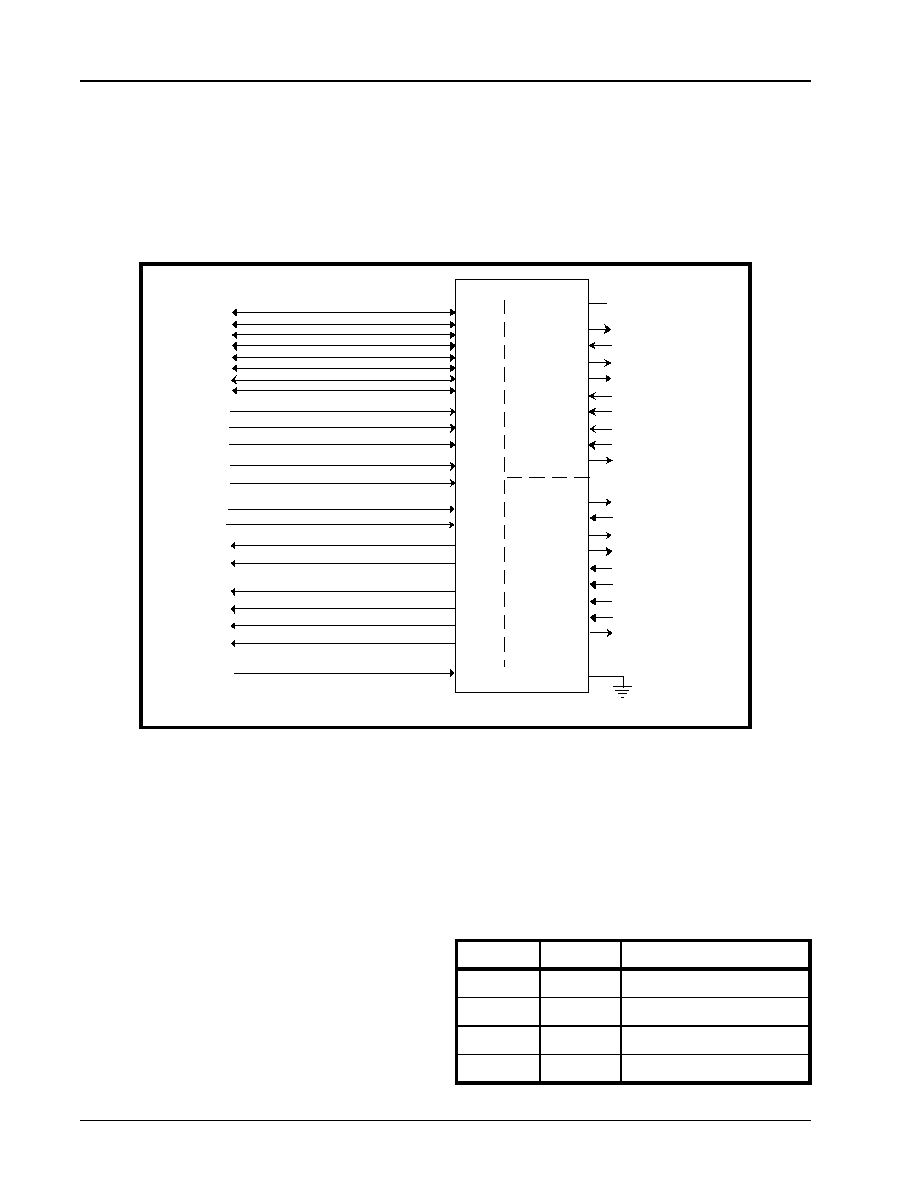
XR16C2850
3.3V AND 5V DUART WITH 128-BYTE FIFO
��
��
��
��
REV. 2.0.0
7
2.0
FUNCTIONAL DESCRIPTIONS
2.1
CPU I
NTERFACE
The CPU interface is 8 data bits wide with 3 address
lines and control signals to execute data bus read and
write transactions. The 2850 data interface supports
the Intel compatible types of CPUs and it is compati-
ble to the industry standard 16C550 UART. No clock
(oscillator nor external clock) is required to operate a
data bus transaction. Each bus cycle is asynchronous
using CS#, IOR# and IOW# signals. Both UART
channels share the same data bus for host opera-
tions. The data bus interconnections are shown in
Figure 3.
2.2
D
EVICE
R
ESET
The RESET input resets the internal registers and the
serial interface outputs in both channels to their de-
fault state (see Table 16 on page 30). An active high
pulse of longer than 40 ns duration will be required to
activate the reset function in the device.
2.3
D
EVICE
I
DENTIFICATION
AND
R
EVISION
The XR16C2850 provides a Device Identification
code and a Device Revision code to distinguish the
part from other devices and revisions. To read the
identification code from the part, it is required to set
the baud rate generator registers DLL and DLM both
to 0x00. Now reading the content of the DLM will pro-
vide 0x12 for the XR16C2850 and reading the con-
tent of DLL will provide the revision of the part; for ex-
ample, a reading of 0x01 means revision A.
2.4
C
HANNEL
A
AND
B S
ELECTION
The UART provides the user with the capability to bi-
directionally transfer information between an external
CPU and an external serial communication device. A
logic 0 on chip select pins, CSA# or CSB#, allows the
user to select UART channel A or B to configure,
send transmit data and/or unload receive data to/from
the UART. Selecting both UARTs can be useful dur-
ing power up initialization to write to the same internal
registers, but do not attempt to read from both uarts
simultaneously. Individual channel select functions
are shown in Table 1.
F
IGURE
3. XR16C2850 D
ATA
B
US
I
NTERCONNECTIONS
VCC
VCC
OP2A#
DSRA#
CTSA#
RTSA#
DTRA#
RXA
TXA
RIA#
CDA#
OP2B#
DSRB#
CTSB#
RTSB#
DTRB#
RXB
TXB
RIB#
CDB#
GND
A0
A1
A2
UART_CSA#
UART_CSB#
IOR#
IOW#
D0
D1
D2
D3
D4
D5
D6
D7
A0
A1
A2
CSA#
CSB#
D0
D1
D2
D3
D4
D5
D6
D7
IOR#
IOW#
UART
Channel A
UART
Channel B
UART_INTB
UART_INTA
INTB
INTA
RXRDYA#
TXRDYA#
RXRDYA#
TXRDYA#
RXRDYB#
TXRDYB#
RXRDYB#
TXRDYB#
UART_RESET
RESET
Serial Interface of
RS-232, RS-485
Serial Interface of RS-
232, RS-485
2750int
T
ABLE
1: C
HANNEL
A
AND
B S
ELECT
CSA#
CSB#
F
UNCTION
1
1
UART de-selected
0
1
Channel A selected
1
0
Channel B selected
0
0
Channel A and B selected
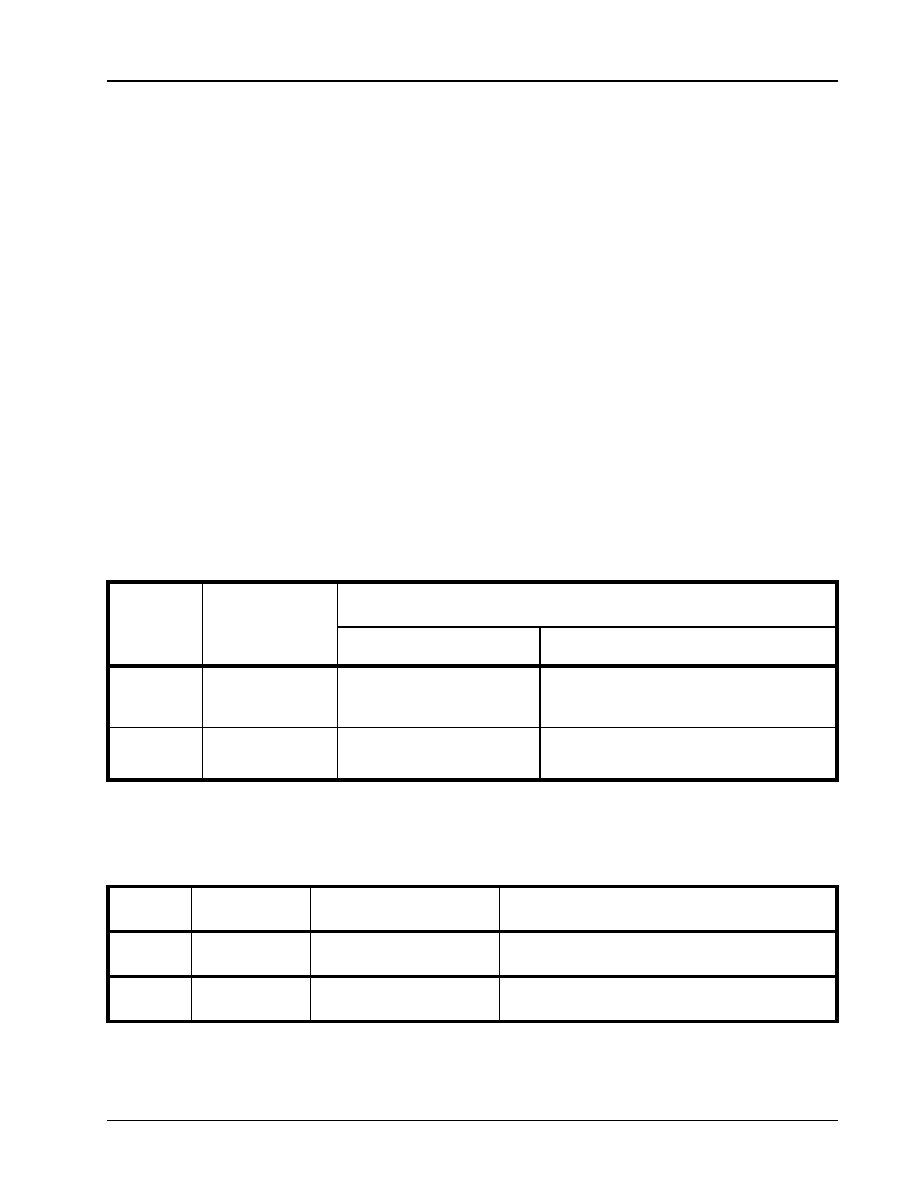
��
��
��
��
3.3V AND 5V DUART WITH 128-BYTE FIFO
XR16C2850
REV. 2.0.0
8
2.5
C
HANNEL
A
AND
B I
NTERNAL
R
EGISTERS
Each UART channel in the 2850 has a set of en-
hanced registers for control, monitoring and data
loading and unloading. The configuration register set
is compatible to those already available in the stan-
dard single 16C550 and dual ST16C2550. These
registers function as data holding registers (THR/
RHR), interrupt status and control registers (ISR/
IER), a FIFO control register (FCR), receive line sta-
tus and control registers (LSR/LCR), modem status
and control registers (MSR/MCR), programmable da-
ta rate (clock) divisor registers (DLL/DLM), and a user
accessible scratchpad register (SPR).
Beyond the general 16C2550 features and capabili-
ties, the 2850 offers enhanced feature registers (EM-
SR, FLVL, EFR, Xon/Xoff 1, Xon/Xoff 2, FCTR, TRG,
FC) that provide automatic RTS and CTS hardware
flow control, Xon/Xoff software flow control, automatic
RS-485 half-duplex direction output enable/disable,
FIFO trigger level control, and FIFO level counters.
All the register functions are discussed in full detail
later in "UART INTERNAL REGISTERS" on page 18.
2.6
DMA M
ODE
The device does not support direct memory access.
The DMA Mode (a legacy term) in this document
doesn't mean "direct memory access" but refers to
data block transfer operation. The DMA mode affects
the state of the RXRDY# A/B and TXRDY# A/B output
pins. The transmit and receive FIFO trigger levels
provide additional flexibility to the user for block mode
operation. The LSR bits 5-6 provide an indication
when the transmitter is empty or has an empty loca-
tion(s) for more data. The user can optionally operate
the transmit and receive FIFO in the DMA mode
(FCR bit-3=1). When the transmit and receive FIFO
are enabled and the DMA mode is disabled (FCR bit-
3 = 0), the 2850 is placed in single-character mode
for data transmit or receive operation. When DMA
mode is enabled (FCR bit-3 = 1), the user takes ad-
vantage of block mode operation by loading or un-
loading the FIFO in a block sequence determined by
the programmed trigger level. In this mode, the 2850
sets the TXRDY# pin when the transmit FIFO be-
comes full, and sets the RXRDY# pin when the re-
ceive FIFO becomes empty. The following table
shows their behavior. Also see Figures 18
through 23.
2.7
INTA
AND
INTB O
UPUTS
The INTA and INTB interrupt output output changes
according to the operating mode and enahnced fea-
tures setup. Table 3 and 4 summarize the operating
behavior for the transmitter and receiver. Also see
Figures 18 through 23.
T
ABLE
2: TXRDY#
AND
RXRDY# O
UTPUTS
IN
FIFO
AND
DMA M
ODE
P
INS
FCR
BIT
-0=0
(FIFO D
ISABLED
)
FCR B
IT
-0=1 (FIFO E
NABLED
)
FCR Bit-3 = 0
(DMA Mode Disabled)
FCR Bit-3 = 1
(DMA Mode Enabled)
RXRDY# A/B 0 = 1 byte.
1 = no data.
0 = at least 1 byte in FIFO
1 = FIFO empty.
1 to 0 transition when FIFO reaches the trigger
level, or timeout occurs.
0 to 1 transition when FIFO empties.
TXRDY# A/B
0 = THR empty.
1 = byte in THR.
0 = FIFO empty.
1 = at least 1 byte in FIFO.
0 = FIFO has at least 1 empty location.
1 = FIFO is full.
T
ABLE
3: INTA
AND
INTB P
INS
O
PERATION
FOR
T
RANSMITTER
Auto RS485 Mode
FCR B
IT
-0 = 0
(FIFO D
ISABLED
)
FCR B
IT
-0 = 1
(FIFO E
NABLED
)
INTA/B Pin
NO
0 = a byte in THR
1 = THR empty
0 = FIFO above trigger level
1 = FIFO below trigger level or FIFO empty
INTA/B Pin
YES
0 = a byte in THR
1 = transmitter empty
0 = FIFO above trigger level
1 = FIFO below trigger level or transmitter empty
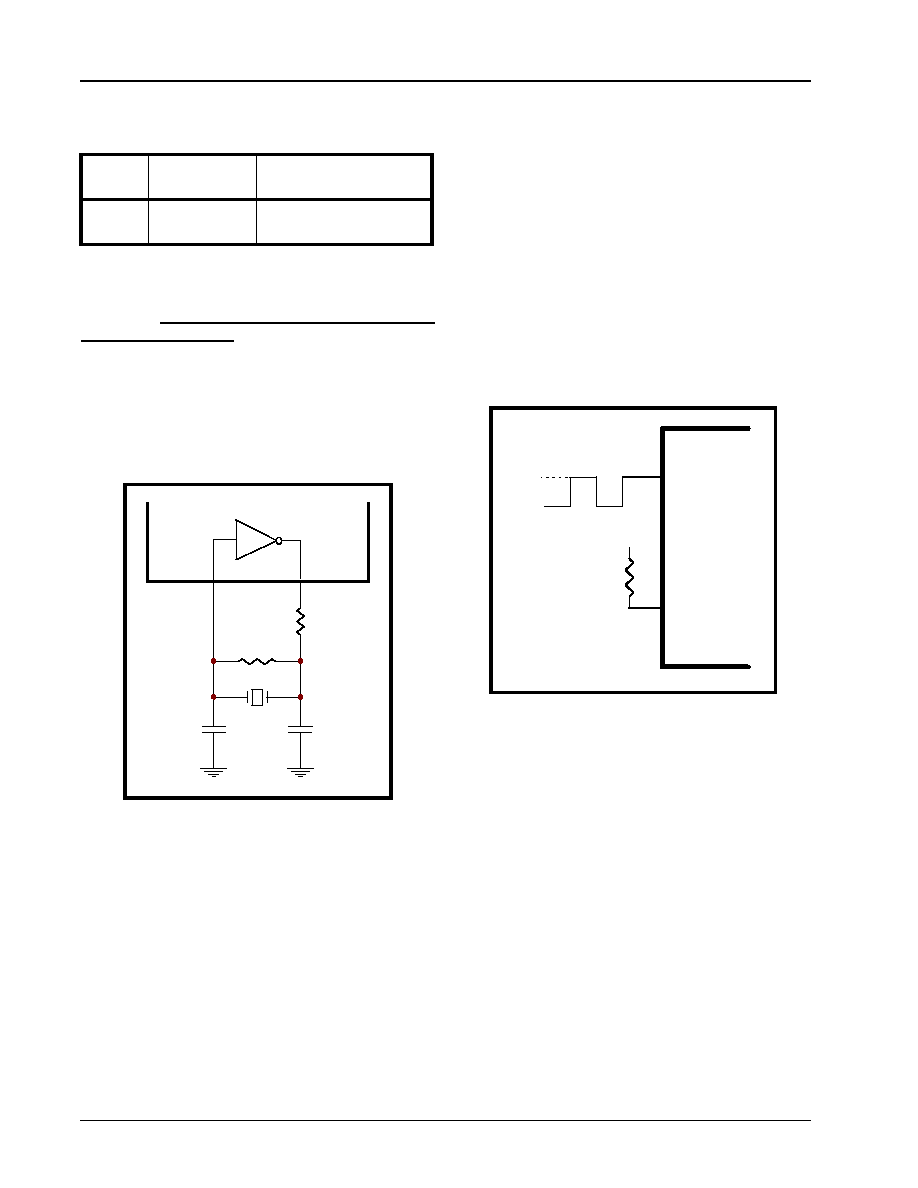
XR16C2850
3.3V AND 5V DUART WITH 128-BYTE FIFO
��
��
��
��
REV. 2.0.0
9
2.8
C
RYSTAL
O
SCILLATOR
OR
E
XT
. C
LOCK
I
NPUT
The 2850 includes an on-chip oscillator (XTAL1 and
XTAL2) to produce a clock for both UART sections in
the device. The CPU data bus does not require this
clock for bus operation. The crystal oscillator provides
a system clock to the Baud Rate Generators (BRG)
section found in each of the UART. XTAL1 is the input
to the oscillator or external clock buffer input with
XTAL2 pin being the output. For programming details,
see "Programmable Baud Rate Generator."
MP
The on-chip oscillator is designed to use an industry
standard microprocessor crystal (parallel resonant,
fundamental frequency with 10-22 pF capacitance
load, ESR of 20-80 ohms and 100ppm frequency tol-
erance) connected externally between the XTAL1 and
XTAL2 pins (see Figure 4). Alternatively, an external
clock can be connected to the XTAL1 pin to clock the
internal baud rate generator for standard or custom
rates. Typical oscillator connections are shown in
Figure 4. For further reading on oscillator circuit
please see application note DAN108 on EXAR's web
site.
2.9
P
ROGRAMMABLE
B
AUD
R
ATE
G
ENERATOR
A single Baud Rate Generator (BRG) is provided for
the transmitter and receiver, allowing independent
TX/RX channel control. The programmable Baud
Rate Generator is capable of operating with a crystal
frequency of up to 24 MHz. However, with an external
clock input on XTAL1 pin and a 2K ohms pull-up re-
sistor on XTAL2 pin (as shown in Figure 5) it can ex-
tend its operation up to 50 MHz (3.125 Mbps serial
data rate) at room temperature and 5.0V.
Each UART also has their own prescaler along with
the BRG. The prescaler is controlled by CLKSEL
hardware pin or a software bit in the MCR register.
The MCR register bit-7 sets the prescaler to divide
the input crystal or external clock by 1 or 4 and can
override the CLKSEL pin following reset. The clock
output of the prescaler goes to the BRG. The BRG
further divides this clock by a programmable divisor
between 1 and (2
16
-1) to obtain a 16X sampling rate
clock of the serial data rate. The sampling rate clock
is used by the transmitter for data bit shifting and
re-
ceiver for data sampling.
T
ABLE
4: INTA
AND
INTB P
IN
O
PERATION
F
OR
R
ECEIVER
FCR B
IT
-0 = 0
(FIFO D
ISABLED
)
FCR B
IT
-0 = 1
(FIFO E
NABLED
)
INTA/B Pin 0 = no data
1 = 1 byte
0 = FIFO below trigger level
1 = FIFO above trigger level
F
IGURE
4. T
YPICAL
OSCILLATOR
CONNECTIONS
C1
22-47 pF
C2
22-47 pF
Y1
1.8432 MHz
to
24 MHz
R1
0-120
(Optional)
R2
500 - 1
XTAL1
XTAL2
F
IGURE
5. E
XTERNAL
C
LOCK
C
ONNECTION
FOR
E
XTENDED
D
ATA
R
ATE
2K
XTAL1
XTAL2
R1
VCC
External Clock
vcc
gnd
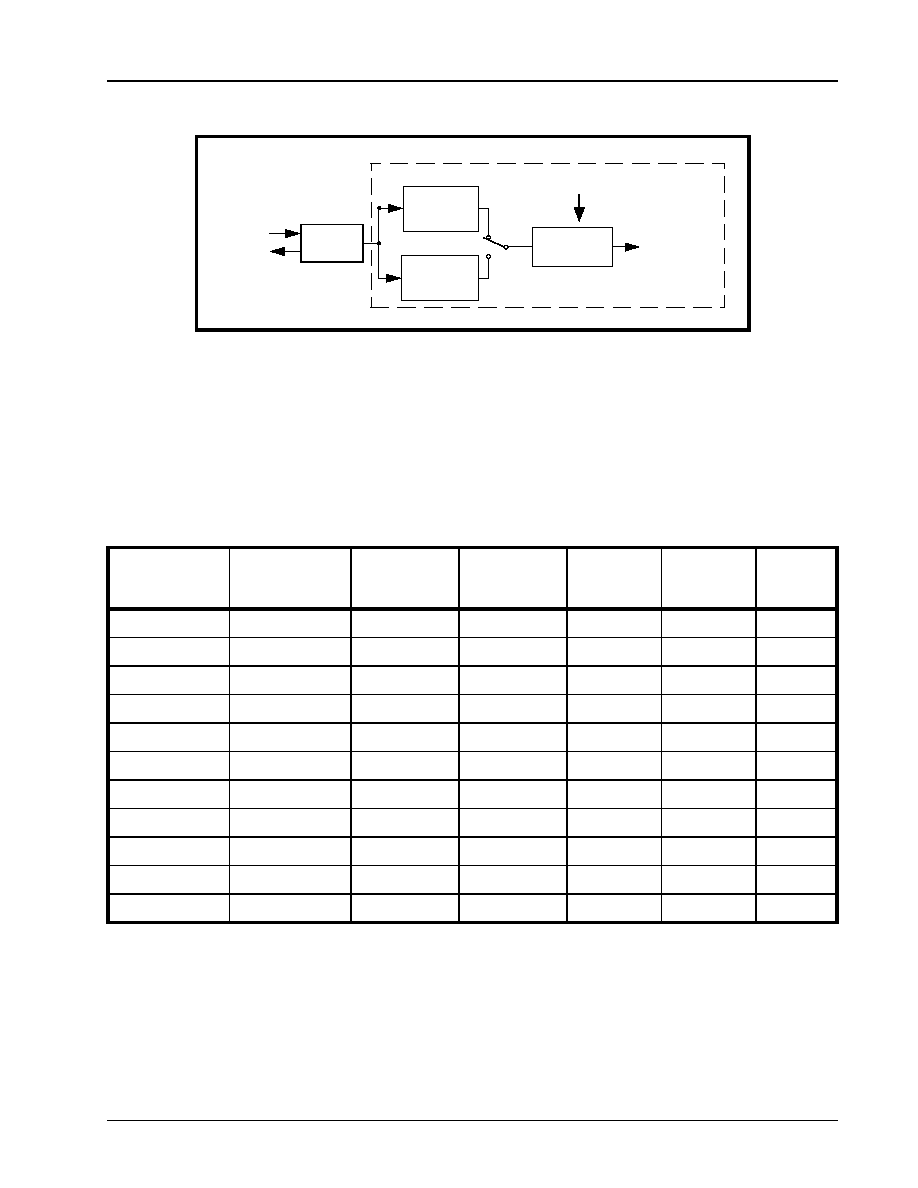
��
��
��
��
3.3V AND 5V DUART WITH 128-BYTE FIFO
XR16C2850
REV. 2.0.0
10
Programming the Baud Rate Generator Registers
DLM and DLL provides the capability of selecting the
operating data rate. Table 5 shows the standard data
rates available with a 14.7456 MHz crystal or external
clock at 16X sampling rate clock rate. A 16X sampling
clock is typically used. However, user can select the
8X sampling clock rate mode to double the operating
data rate. When using a non-standard data rate crys-
tal or external clock, the divisor value can be calculat-
ed for DLL/DLM with the following equation.
F
IGURE
6. B
AUD
R
ATE
G
ENERATOR
AND
P
RESCALER
X T A L 1
X T A L 2
C ry s ta l
O s c /
B u ffe r
M C R B it-7 = 0
(d e fa u lt)
M C R B it-7 = 1
D L L a n d D L M
R e g iste rs
P re s ca le r
D iv id e b y 1
P re s ca le r
D iv id e b y 4
1 6 X
S a m p lin g
R a te C lo c k to
T ra n sm itte r
B a u d R a te
G e n e ra to r
L o g ic
divisor (decimal) = (XTAL1 clock frequency / prescaler) / (serial data rate x 16), with CLK8/16 pin = 1
divisor (decimal) = (XTAL1 clock frequency / prescaler) / (serial data rate x 8), with CLK8/16 pin = 0
T
ABLE
5: T
YPICAL
DATA
RATES
WITH
A
14.7456 MH
Z
CRYSTAL
OR
EXTERNAL
CLOCK
O
UTPUT
Data Rate
MCR Bit-7=1
O
UTPUT
Data Rate
MCR Bit-7=0
(D
EFAULT
)
D
IVISOR
FOR
16x
Clock (Decimal)
D
IVISOR
FOR
16x
Clock (HEX)
DLM
P
ROGRAM
V
ALUE
(HEX)
DLL
P
ROGRAM
V
ALUE
(HEX)
D
ATA
R
ATE
E
RROR
(%)
100
400
2304
900
09
00
0
600
2400
384
180
01
80
0
1200
4800
192
C0
00
C0
0
2400
9600
96
60
00
60
0
4800
19.2k
48
30
00
30
0
9600
38.4k
24
18
00
18
0
19.2k
76.8k
12
0C
00
0C
0
38.4k
153.6k
6
06
00
06
0
57.6k
230.4k
4
04
00
04
0
115.2k 460.8k
2
02
00
02
0
230.4k
921.6k
1
01
00
01
0

XR16C2850
3.3V AND 5V DUART WITH 128-BYTE FIFO
��
��
��
��
REV. 2.0.0
11
2.10 T
RANSMITTER
The transmitter section comprises of an 8-bit Transmit
Shift Register (TSR) and 128 bytes of FIFO which in-
cludes a byte-wide Transmit Holding Register (THR).
TSR shifts out every data bit with the 16X/8X internal
clock. A bit time is 16 (8) clock periods (see CLK8/16
pin description). The transmitter sends the start-bit
followed by the number of data bits, inserts the proper
parity-bit if enabled, and adds the stop-bit(s). The sta-
tus of the FIFO and TSR are reported in the Line Sta-
tus Register (LSR bit-5 and bit-6).
2.10.1 Transmit Holding Register (THR) - Write
Only
The transmit holding register is an 8-bit register pro-
viding a data interface to the host processor. The host
writes transmit data byte to the THR to be converted
into a serial data stream including start-bit, data bits,
parity-bit and stop-bit(s). The least-significant-bit (Bit-
0) becomes first data bit to go out. The THR is the in-
put register to the transmit FIFO of 128 bytes when
FIFO operation is enabled by FCR bit-0. Every time a
write operation is made to the THR, the FIFO data
pointer is automatically bumped to the next sequential
data location.
2.10.2 Transmitter Operation in non-FIFO Mode
The host loads transmit data to THR one character at
a time. The THR empty flag (LSR bit-5) is set when
the data byte is transferred to TSR. THR flag can
generate a transmit empty interrupt (ISR bit-1) when
it is enabled by IER bit-1. The TSR flag (LSR bit-6) is
set when TSR becomes completely empty.
2.10.3 Transmitter Operation in FIFO Mode
The host may fill the transmit FIFO with up to 128
bytes of transmit data. The THR empty flag (LSR bit-
5) is set whenever the FIFO is empty. The THR empty
flag can generate a transmit empty interrupt (ISR bit-
1) when the amount of data in the FIFO falls below its
programmed trigger level. The transmit empty inter-
rupt is enabled by IER bit-1. The TSR flag (LSR bit-6)
is set when TSR/FIFO becomes empty.
F
IGURE
7. T
RANSMITTER
O
PERATION
IN
NON
-FIFO M
ODE
Transmit
Holding
Register
(THR)
Transmit Shift Register (TSR)
Data
Byte
L
S
B
M
S
B
THR Interrupt (ISR bit-1)
Enabled by IER bit-1
TXNOFIFO1
16X or 8X
Clock
(EMSR Bit-7)
F
IGURE
8. T
RANSMITTER
O
PERATION
IN
FIFO
AND
F
LOW
C
ONTROL
M
ODE
Transm it Data Shift Register
(TSR)
Transm it
Data Byte
THR Interrupt (ISR bit-1) falls
below the program m ed Trigger
Level and then when becom es
em pty. FIFO is Enabled by FCR
bit-0=1
Transm it
FIFO
16X or 8X
Clock
Auto CTS Flow Control (CTS# pin)
Auto Software Flow Control
Flow Control Characters
(Xoff1/2 and Xon1/2 Reg.
T XF IF O 1
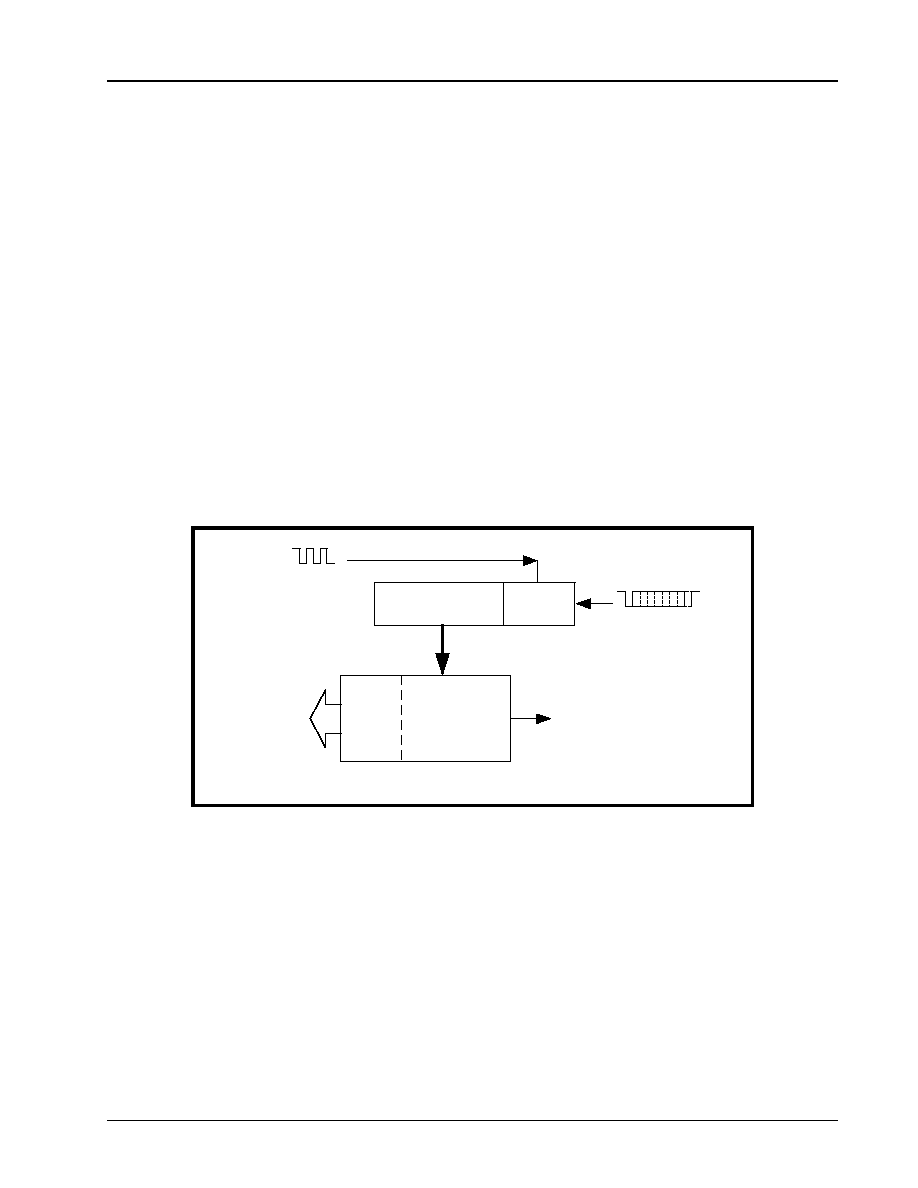
��
��
��
��
3.3V AND 5V DUART WITH 128-BYTE FIFO
XR16C2850
REV. 2.0.0
12
2.11 R
ECEIVER
The receiver section contains an 8-bit Receive Shift
Register (RSR) and 128 bytes of FIFO which includes
a byte-wide Receive Holding Register (RHR). The
RSR uses the 16X/8X clock (CLK8/16 pin) for timing.
It verifies and validates every bit on the incoming
character in the middle of each data bit. On the falling
edge of a start or false start bit, an internal receiver
counter starts counting at the 16X/8X clock rate. After
8 clocks (or 4 if 8X) the start bit period should be at
the center of the start bit. At this time the start bit is
sampled and if it is still a logic 0 it is validated. Evalu-
ating the start bit in this manner prevents the receiver
from assembling a false character. The rest of the da-
ta bits and stop bits are sampled and validated in this
same manner to prevent false framing. If there were
any error(s), they are reported in the LSR register bits
2-4. Upon unloading the receive data byte from RHR,
the receive FIFO pointer is bumped and the error tags
are immediately updated to reflect the status of the
data byte in RHR register. RHR can generate a re-
ceive data ready interrupt upon receiving a character
or delay until it reaches the FIFO trigger level. Fur-
thermore, data delivery to the host is guaranteed by a
receive data ready time-out interrupt when data is not
received for 4 word lengths as defined by LCR[1:0]
plus 12 bits time. This is equivalent to 3.7-4.6 charac-
ter times. The RHR interrupt is enabled by IER bit-0.
2.11.1 Receive Holding Register (RHR) - Read-
Only
The Receive Holding Register is an 8-bit register that
holds a receive data byte from the Receive Shift Reg-
ister. It provides the receive data interface to the host
processor. The RHR register is part of the receive
FIFO of 128 bytes by 11-bits wide, the 3 extra bits are
for the 3 error tags to be reported in LSR register.
When the FIFO is enabled by FCR bit-0, the RHR
contains the first data character received by the FIFO.
After the RHR is read, the next character byte is load-
ed into the RHR and the errors associated with the
current data byte are immediately updated in the LSR
bits 2-4.
F
IGURE
9. R
ECEIVER
O
PERATION
IN
NON
-FIFO M
ODE
Receive Data Shift
Register (RSR)
Receive
Data Byte
and Errors
RHR Interrupt (ISR bit-2)
Receive Data
Holding Register
(RHR)
RXFIFO1
16X or 8X
Clock
Receive Data Characters
Data Bit
Validation
Error
Tags in
LSR bits
4:2

XR16C2850
3.3V AND 5V DUART WITH 128-BYTE FIFO
��
��
��
��
REV. 2.0.0
13
N
OTE
:
Table-B selected as Trigger Table for Figure 10 (Table 10
on page 23).
2.12 A
UTO
RTS (H
ARDWARE
) F
LOW
C
ONTROL
Automatic RTS hardware flow control is used to pre-
vent data overrun to the local receiver FIFO. The
RTS# output is used to request remote unit to sus-
pend/resume data transmission. The auto RTS flow
control features is enabled to fit specific application
requirement (see Figure 11):
� Enable auto RTS flow control using EFR bit-6.
� The auto RTS function must be started by asserting
RTS# output pin (MCR bit-1 to logic 1 after it is
enabled).
� Enable RTS interrupt through IER bit-6 (after set-
ting EFR bit-4). The UART issues an interrupt when
the RTS# pin makes a transition from low to high:
ISR bit-5 will be set to logic 1.
2.13 A
UTO
RTS H
YSTERESIS
The 2850 has a new feature that provides flow control
trigger hysteresis while maintaining compatibility with
the XR16C850, ST16C650A and ST16C550 family of
UARTs. With the Auto RTS function enabled, an in-
terrupt is generated when the receive FIFO reaches
the programmed RX trigger level. The RTS# pin will
not be forced to a logic 1 (RTS off), until the receive
FIFO reaches the upper limit of the hysteresis level.
The RTS# pin will return to a logic 0 after the RX
FIFO is unloaded to the lower limit of the hysteresis
level. Under the above described conditions, the
2850 will continue to accept data until the receive
FIFO gets full. The Auto RTS function is initiated
when the RTS# output pin is asserted to a logic 0
(RTS On). Table 13 shows the complete details for
the Auto RTS# Hysteresis levels. Please note that
this table is for programmable trigger levels only (Ta-
ble D). The hysteresis values for Tables A-C are the
next higher and next lower trigger levels in the corre-
sponding table.
2.14 A
UTO
CTS F
LOW
C
ONTROL
Automatic CTS flow control is used to prevent data
overrun to the remote receiver FIFO. The CTS# input
is monitored to suspend/restart the local transmitter.
The auto CTS flow control feature is selected to fit
specific application requirement (see Figure 11):
� Enable auto CTS flow control using EFR bit-7.
� - Enable CTS interrupt through IER bit-7 (after set-
ting EFR bit-4). The UART issues an interrupt when
the CTS# pin is de-asserted (logic 1): ISR bit-5 will
be set to 1, and UART will suspend transmission as
soon as the stop bit of the character in process is
shifted out. Transmission is resumed after the
CTS# input is re-asserted (logic 0), indicating more
data may be sent.
F
IGURE
10. R
ECEIVER
O
PERATION
IN
FIFO
AND
A
UTO
RTS F
LOW
C
ONTROL
M
ODE
Receive Data Shift
Register (RSR)
RXFIFO1
16X or 8X
Clock
E
rro
r T
a
g
s
(1
2
8
-s
e
t
s
)
E
rro
r T
a
g
s
in
LS
R
bit
s 4
:
2
128 bytes by 11-bit
wide FIFO
Receive Data Characters
FIFO Trigger=16
Example:
- RX FIFO trigger level selected at 16 bytes
(See Note Below)
Data fills to 24
Data falls to 8
Data Bit
Validation
Receive
Data FIFO
Receive
Data
Receive Data
Byte and Errors
RHR Interrupt (ISR bit-2) programmed for
desired FIFO trigger level.
FIFO is Enabled by FCR bit-0=1
RTS# de-asserts when data fills above the flow
control trigger level to suspend remote transmitter.
Enable by EFR bit-6=1, MCR bit-1.
RTS# re-asserts when data falls below the flow
control trigger level to restart remote transmitter.
Enable by EFR bit-6=1, MCR bit-1.

��
��
��
��
3.3V AND 5V DUART WITH 128-BYTE FIFO
XR16C2850
REV. 2.0.0
14
2.15 A
UTO
X
ON
/X
OFF
(S
OFTWARE
) F
LOW
C
ONTROL
When software flow control is enabled (See
Table 15), the 2850 compares one or two sequential
receive data characters with the programmed Xon or
Xoff-1,2 character value(s). If receive character(s)
(RX) match the programmed values, the 2850 will halt
transmission (TX) as soon as the current character
has completed transmission. When a match occurs,
the Xoff (if enabled via IER bit-5) flag will be set and
the interrupt output pin will be activated. Following a
suspension due to a match of the Xoff character, the
2850 will monitor the receive data stream for a match
to the Xon-1,2 character. If a match is found, the 2850
will resume operation and clear the flags (ISR bit-4).
Reset initially sets the contents of the Xon/Xoff 8-bit
flow control registers to a logic 0. Following reset the
user can write any Xon/Xoff value desired for soft-
ware flow control. Different conditions can be set to
detect Xon/Xoff characters (See Table 15) and sus-
pend/resume transmissions. When double 8-bit Xon/
Xoff characters are selected, the 2850 compares two
consecutive receive characters with two software flow
control 8-bit values (Xon1, Xon2, Xoff1, Xoff2) and
controls TX transmissions accordingly. Under the
above described flow control mechanisms, flow con-
trol characters are not placed (stacked) in the user
accessible RX data buffer or FIFO.
In the event that the receive buffer is overfilling and
flow control needs to be executed, the 2850 automat-
ically sends an Xoff message (when enabled) via the
serial TX output to the remote modem. The 2850
sends the Xoff-1,2 characters two-character-times (=
F
IGURE
11. A
UTO
RTS
AND
CTS F
LOW
C
ONTROL
O
PERATION
The local UART (UARTA) starts data transfer by asserting RTSA# (1). RTSA# is normally connected to CTSB# (2) of
remote UART (UARTB). CTSB# allows its transmitter to send data (3). TXB data arrives and fills UARTA receive FIFO
(4). When RXA data fills up to its receive FIFO trigger level, UARTA activates its RXA data ready interrupt (5) and con-
tinues to receive and put data into its FIFO. If interrupt service latency is long and data is not being unloaded, UARTA
monitors its receive data fill level to match the upper threshold of RTS delay and de-assert RTSA# (6). CTSB# follows
(7) and request UARTB transmitter to suspend data transfer. UARTB stops or finishes sending the data bits in its transmit
shift register (8). When receive FIFO data in UARTA is unloaded to match the lower threshold of RTS delay (9), UARTA
re-asserts RTSA# (10), CTSB# recognizes the change (11) and restarts its transmitter and data flow again until next
receive FIFO trigger (12). This same event applies to the reverse direction when UARTA sends data to UARTB with
RTSB# and CTSA# controlling the data flow.
RTSA#
CTSB#
RXA
TXB
Transmitter
Receiver FIFO
Trigger Reached
Auto RTS
Trigger Level
Auto CTS
Monitor
RTSA#
TXB
RXA FIFO
CTSB#
Remote UART
UARTB
Local UART
UARTA
ON
OFF
ON
Suspend
Restart
RTS High
Threshold
Data Starts
ON
OFF
ON
Assert RTS# to Begin
Transmission
1
2
3
4
5
6
7
Receive
Data
RTS Low
Threshold
9
10
11
Receiver FIFO
Trigger Reached
Auto RTS
Trigger Level
Transmitter
Auto CTS
Monitor
RTSB#
CTSA#
RXB
TXA
INTA
(RXA FIFO
Interrupt)
RX FIFO
Trigger Level
RX FIFO
Trigger Level
8
12
RTSCTS1

XR16C2850
3.3V AND 5V DUART WITH 128-BYTE FIFO
��
��
��
��
REV. 2.0.0
15
time taken to send two characters at the programmed
baud rate) after the receive FIFO crosses the pro-
grammed trigger level (for all trigger tables A-D). To
clear this condition, the 2850 will transmit the pro-
grammed Xon-1,2 characters as soon as receive
FIFO is less than one trigger level below the pro-
grammed trigger level (for Trigger Tables A, B, and C)
or when receive FIFO is less than the trigger level mi-
nus the hysteresis value (for Trigger Table D). This
hysteresis value is the same as the Auto RTS Hyster-
esis value in Table 13. Table 6 below explains this
when Trigger Table-B (See Table 10) is selected.
* After the trigger level is reached, an xoff character is sent after a short span of time (= time required to send 2
characters); for example, after 2.083ms has elapsed for 9600 baud and 10-bit word length setting.
2.16 S
PECIAL
C
HARACTER
D
ETECT
A special character detect feature is provided to de-
tect an 8-bit character when bit-5 is set in the En-
hanced Feature Register (EFR). When this character
(Xoff2) is detected, it will be placed in the FIFO along
with normal incoming RX data.
The 2850 compares each incoming receive character
with Xoff-2 data. If a match exists, the received data
will be transferred to FIFO and ISR bit-4 will be set to
indicate detection of special character. Although the
Internal Register Table shows Xon, Xoff Registers
with eight bits of character information, the actual
number of bits is dependent on the programmed word
length. Line Control Register (LCR) bits 0-1 defines
the number of character bits, i.e., either 5 bits, 6 bits,
7 bits, or 8 bits. The word length selected by LCR bits
0-1 also determines the number of bits that will be
used for the special character comparison. Bit-0 in
the Xon, Xoff Registers corresponds with the LSB bit
for the receive character.
2.17 A
UTO
RS485 H
ALF
-
DUPLEX
C
ONTROL
The auto RS485 half-duplex direction control chang-
es the behavior of the transmitter when enabled by
FCTR bit-3. It de-asserts RTS# output following
the
last stop bit of the last character that has been trans-
mitted. This helps in turning around the transceiver to
receive the remote station's response. When the host
is ready to transmit next polling data packet again, it
only has to load data bytes to the transmit FIFO. The
transmitter automatically re-asserts RTS# output pri-
or sending the data.
2.18 I
NFRARED
M
ODE
The 2850 UART includes the infrared encoder and
decoder compatible to the IrDA (Infrared Data Associ-
ation) version 1.0. The IrDA 1.0 standard that stipu-
lates the infrared encoder sends out a
3/16 of a bit
wide HIGH-pulse for each "0" bit in the transmit data
stream. This signal encoding reduces the on-time of
the infrared LED, hence reduces the power consump-
tion. See
Figure 12
below.
The infrared encoder and decoder are enabled by
setting MCR register bit-6 to a `1'. When the infrared
feature is enabled, the transmit data output, TX, idles
at logic zero level. Likewise, the RX input assumes an
idle level of logic zero from a reset and power up, see
Figure 12.
Typically, the wireless infrared decoder receives the
input pulse from the infrared sensing diode on the RX
pin. Each time it senses a light pulse, it returns a logic
1 to the data bit stream. However, this is not true with
some infrared modules on the market which indicate
a logic 0 by a light pulse. So the 2850 has a provision
to invert the input polarity to accomodate this. In this
case user can enable FCTR bit-2 to invert the input
signal.
T
ABLE
6: A
UTO
X
ON
/X
OFF
(S
OFTWARE
) F
LOW
C
ONTROL
RX T
RIGGER
L
EVEL
INT P
IN
A
CTIVATION
X
OFF
C
HARACTER
(
S
) S
ENT
(
CHARACTERS
IN
RX
FIFO
)
X
ON
C
HARACTER
(
S
) S
ENT
(
CHARACTERS
IN
RX
FIFO
)
8
8
8*
0
16
16
16*
8
24
24
24*
16
28
28
28*
24

��
��
��
��
3.3V AND 5V DUART WITH 128-BYTE FIFO
XR16C2850
REV. 2.0.0
16
2.19 S
LEEP
M
ODE
WITH
A
UTO
W
AKE
-U
P
The 2850 supports low voltage system designs,
hence, a sleep mode is included to reduce its power
consumption when the chip is not actively used. With
EFR bit-4 and IER bit-4 of both channels enabled (set
to a logic 1), the 2850 DUART enters sleep mode
when no interrupt is pending for both channels. The
2850 stops its crystal oscillator to further conserve
power in the sleep mode. User can check the XTAL2
pin for no clock output as an indication that the device
has entered the sleep mode. The 2850 resumes nor-
mal operation by any of the following: a receive data
start bit transition (logic 1 to 0), a change of logic
state on any of the modem or general purpose input
pins: CTS#, DSR#, CD#, RI# or a transmit data byte
is loaded to the THR/FIFO by the user. If the 2850 is
awakened by one of the above conditions, it will re-
turn to the sleep mode automatically after all inter-
rupting condition have been serviced and cleared. In
any case, the sleep mode will not be entered while an
interrupt is pending from channel A or B. The 2850
will stay in the sleep mode of operation until it is dis-
abled by setting IER bit-4 to a logic 0.
A word of caution: owing to the starting up delay of
the crystal oscillator after waking up from sleep
mode, the first few receive characters may be lost. Al-
so, make sure the RX A/B inputs are idling at logic 1
or "marking" condition during sleep mode to avoid re-
ceiving a "break" condition upon the restart. This may
occur when the external interface transceivers (RS-
232, RS-485 or another type) are also put to sleep
mode and cannot maintain the "marking" condition.
To avoid this, the system design engineer can use a
47k ohm pull-up resistor on the RXA and RXB pins.
2.20 I
NTERNAL
L
OOPBACK
The 2850 UART provides an internal loopback capa-
bility for system diagnostic purposes. The internal
loopback mode
is enabled by setting MCR register
bit-4 to logic 1. All regular UART functions operate
normally. Figure 13 shows how the modem port sig-
nals are re-configured. Transmit data from the trans-
mit shift register output is internally routed to the re-
ceive shift register input allowing the system to re-
ceive the same data that it was sending. The TX pin
is held at logic 1 or mark condition while RTS# and
DTR# are de-asserted, and CTS#, DSR# CD# and
RI# inputs are ignored. Caution: the RX input must be
held to a logic 1 during loopback test else upon exit-
ing the loopback test the UART may detect and report
a false "break" signal.
F
IGURE
12. I
NFRARED
T
RANSMIT
D
ATA
E
NCODING
AND
R
ECEIVE
D
ATA
D
ECODING
Character
Data Bits
Start
Stop
0
0
0
0
0
1
1
1
1
1
Bit Time
1/16 Clock Delay
IRdecoder-1
RX Data
Receive
IR Pulse
(RX pin)
C h a ra cte r
D a ta B its
St
ar
t
St
op
0
0
0
0
0
1
1
1
1
1
T X D a ta
T ra n sm it
IR P u lse
(T X P in )
B it T im e
1 /2 B it T im e
3 /1 6 B it T im e
IrE n co d e r-1
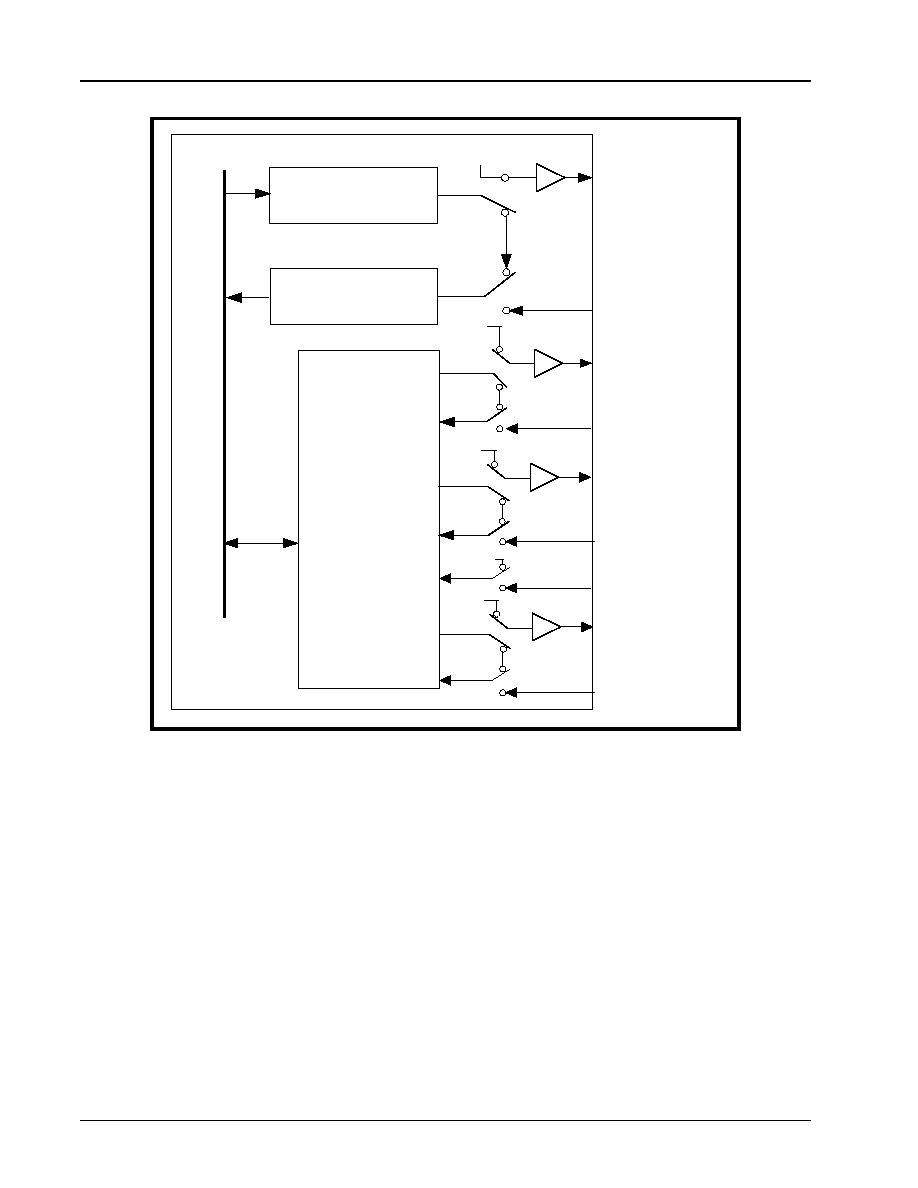
XR16C2850
3.3V AND 5V DUART WITH 128-BYTE FIFO
��
��
��
��
REV. 2.0.0
17
F
IGURE
13. I
NTERNAL
L
OOP
B
ACK
IN
C
HANNEL
A
AND
B
TXA/TXB
RXA/RXB
Mo
dem
/
Ge
ner
al
P
u
r
pos
e C
ont
r
o
l Log
ic
Int
e
r
n
al
D
a
t
a
B
u
s Line
s and C
ont
r
o
l Signa
ls
RTSA#/RTSB#
MCR bit-4=1
VCC
VCC
Transmit Shift Register
(THR/FIFO)
Receive Shift Register
(RHR/FIFO)
CTSA#/CTSB#
DTRA#/DTRB#
DSRA#/DSRB#
RIA#/RIB#
CDA#/CDB#
OP1#
OP2#
RTS#
CTS#
DTR#
DSR#
RI#
CD#
VCC
VCC
OP2A#/OP2B#

��
��
��
��
3.3V AND 5V DUART WITH 128-BYTE FIFO
XR16C2850
REV. 2.0.0
18
3.0
UART INTERNAL REGISTERS
Each of the UART channel in the 2850 has its own set
of configuration registers selected by address lines
A0, A1 and A2 with CSA# or CSB# selecting the
channel. The complete register set is shown on
Table 7 and Table 8.
T
ABLE
7: UART CHANNEL A AND B UART INTERNAL REGISTERS
A2,A1,A0 A
DDRESSES
R
EGISTER
R
EAD
/W
RITE
C
OMMENTS
16C550 C
OMPATIBLE
R
EGISTERS
0 0 0
RHR - Receive Holding Register
THR - Transmit Holding Register
Read-only
Write-only
LCR[7] = 0
0 0 0
DLL - Div Latch Low Byte
Read/Write
LCR[7] = 1, LCR
0xBF
0 0 1
DLM - Div Latch High Byte
Read/Write
0 0 0
DREV - Device Revision Code
Read-only
DLL, DLM = 0x00,
LCR[7] = 1, LCR
0xBF
0 0 1
DVID - Device Identification Code
Read-only
0 0 1
IER - Interrupt Enable Register
Read/Write
LCR[7] = 0
0 1 0
ISR - Interrupt Status Register
FCR - FIFO Control Register
Read-only
Write-only
0 1 1
LCR - Line Control Register
Read/Write
1 0 0
MCR - Modem Control Register
Read/Write
LCR[7] = 0
1 0 1
LSR - Line Status Register
Reserved
Read-only
Write-only
1 1 0
MSR - Modem Status Register
Reserved
Read-only
Write-only
1 1 1
SPR - Scratch Pad Register
Read/Write
LCR[7] = 0, FCTR[6] = 0
1 1 1
FLVL - TX/RX FIFO Level Counter Register
Read-only
LCR[7] = 0, FCTR[6] = 1
1 1 1
EMSR - Enhanced Mode Select Register
Write-only
E
NHANCED
R
EGISTERS
0 0 0
TRG - TX/RX FIFO Trigger Level Reg
FC - TX/RX FIFO Level Counter Register
Write-only
Read-only
LCR = 0xBF
0 0 1
FCTR - Feature Control Reg
Read/Write
0 1 0
EFR - Enhanced Function Reg
Read/Write
1 0 0
Xon-1 - Xon Character 1
Read/Write
1 0 1
Xon-2 - Xon Character 2
Read/Write
1 1 0
Xoff-1 - Xoff Character 1
Read/Write
1 1 1
Xoff-2 - Xoff Character 2
Read/Write
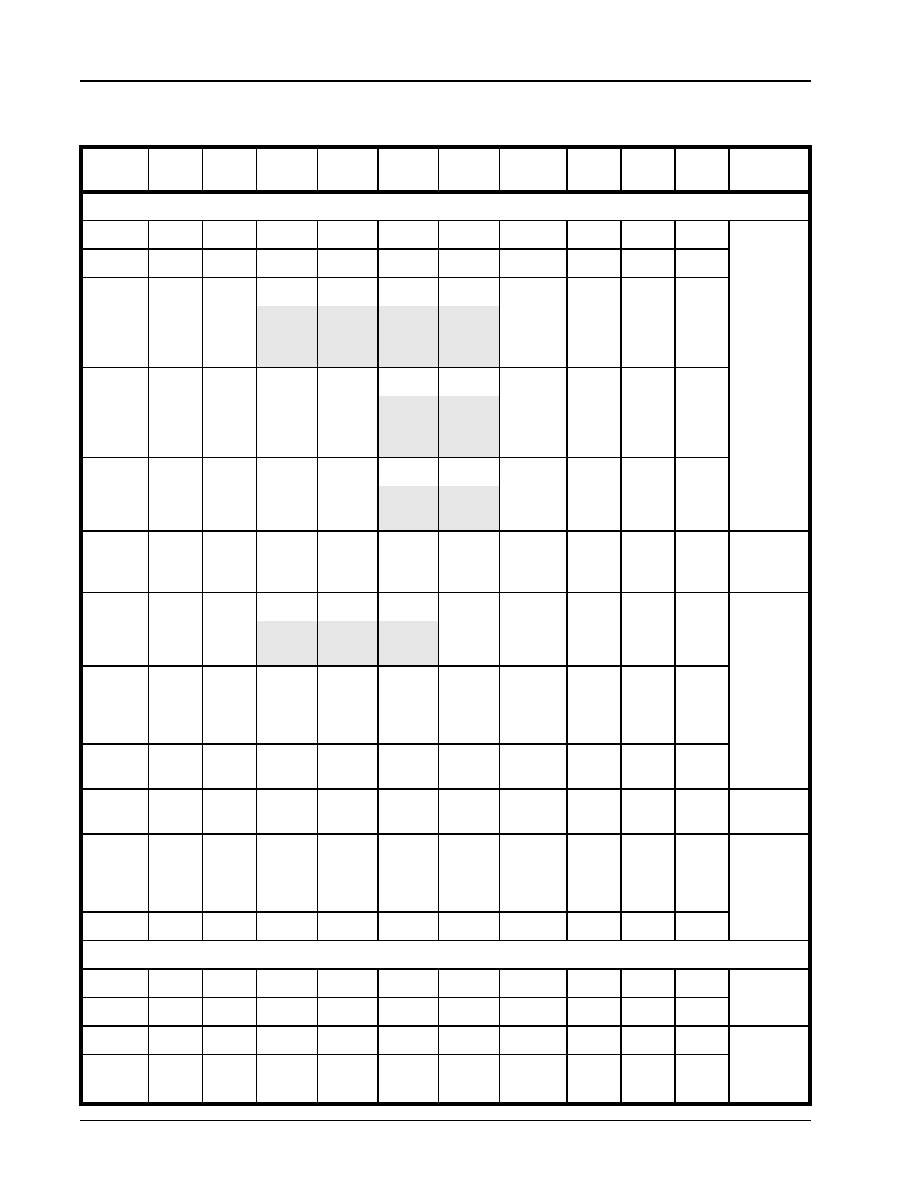
XR16C2850
3.3V AND 5V DUART WITH 128-BYTE FIFO
��
��
��
��
REV. 2.0.0
19
.
T
ABLE
8: INTERNAL REGISTERS DESCRIPTION.
S
HADED
BITS
ARE
ENABLED
WHEN
EFR B
IT
-4=1
A
DDRESS
A2-A0
R
EG
N
AME
R
EAD
/
W
RITE
B
IT
-7
B
IT
-6
B
IT
-5
B
IT
-4
B
IT
-3
B
IT
-2
B
IT
-1
B
IT
-0
C
OMMENT
16C550 Compatible Registers
0 0 0
RHR
RD
Bit-7
Bit-6
Bit-5
Bit-4
Bit-3
Bit-2
Bit-1
Bit-0
LCR[7] = 0
0 0 0
THR
WR
Bit-7
Bit-6
Bit-5
Bit-4
Bit-3
Bit-2
Bit-1
Bit-0
0 0 1
IER
RD/WR
0/
0/
0/
0/
Modem
Status Int.
Enable
RX Line
Status-
Int.
Enable
TX
Empty
Int.
Enable
RX Data
Int.
Enable
CTS# Int.
Enable
RTS# Int.
Enable
Xoff Int..
Enable
Sleep
Mode
Enable
0 1 0
ISR
RD
FIFOs
Enabled
FIFOs
Enabled
0/
0/
INT
Source
Bit-3
INT
Source
Bit-2
INT
Source
Bit-1
INT
Source
Bit-0
INT
Source
Bit-5
INT
Source
Bit-4
0 1 0
FCR
WR
RX FIFO
Trigger
RX FIFO
Trigger
0/
0/
DMA
Mode
Enable
TX
FIFO
Reset
RX
FIFO
Reset
FIFOs
Enable
TX FIFO
Trigger
TX FIFO
Trigger
0 1 1
LCR
RD/WR
Divisor
Enable
Set TX
Break
Set
Parity
Even
Parity
Parity
Enable
Stop
Bits
Word
Length
Bit-1
Word
Length
Bit-0
1 0 0
MCR
RD/WR
0/
0/
0/
Internal
Lopback
Enable
OP2#/INT
Output
Enable
Rsvd
(OP1#)
RTS#
Output
Control
DTR#
Output
Control
LCR[7] = 0
BRG
Prescaler
IR Mode
ENable
XonAny
1 0 1
LSR
RD
RX FIFO
Global
Error
THR &
TSR
Empty
THR
Empty
RX Break RX Fram-
ing Error
RX
Parity
Error
RX
Over-
run
Error
RX Data
Ready
1 1 0
MSR
RD
CD#
Input
RI# Input
DSR#
Input
CTS#
Input
Delta CD#
Delta
RI#
Delta
DSR#
Delta
CTS#
1 1 1
SPR
RD/WR
Bit-7
Bit-6
Bit-5
Bit-4
Bit-3
Bit-2
Bit-1
Bit-0
LCR[7] = 0
FCTR[6]=0
1 1 1
EMSR
WR
Rsvd
Rsvd
Auto
RTS
Hyst.
bit-3
Auto
RTS
Hyst.
bit-2
Rsvd
Rsvd
Rx/Tx
FIFO
Count
Rx/Tx
FIFO
Count
LCR[7] = 0
FCTR[6]=1
1 1 1
FLVL
RD
Bit-7
Bit-6
Bit-5
Bit-4
Bit-3
Bit-2
Bit-1
Bit-0
Baud Rate Generator Divisor
0 0 0
DLL
RD/WR
Bit-7
Bit-6
Bit-5
Bit-4
Bit-3
Bit-2
Bit-1
Bit-0
LCR[7] = 1
LCR
0xBF
0 0 1
DLM
RD/WR
Bit-7
Bit-6
Bit-5
Bit-4
Bit-3
Bit-2
Bit-1
Bit-0
0 0 0
DREV
RD
Bit-7
Bit-6
Bit-5
Bit-4
Bit-3
Bit-2
Bit-1
Bit-0
LCR[7] = 1
LCR
0xBF
DLL=0x00
DLM=0x00
0 0 1
DVID
RD
0
0
0
1
0
0
1
0
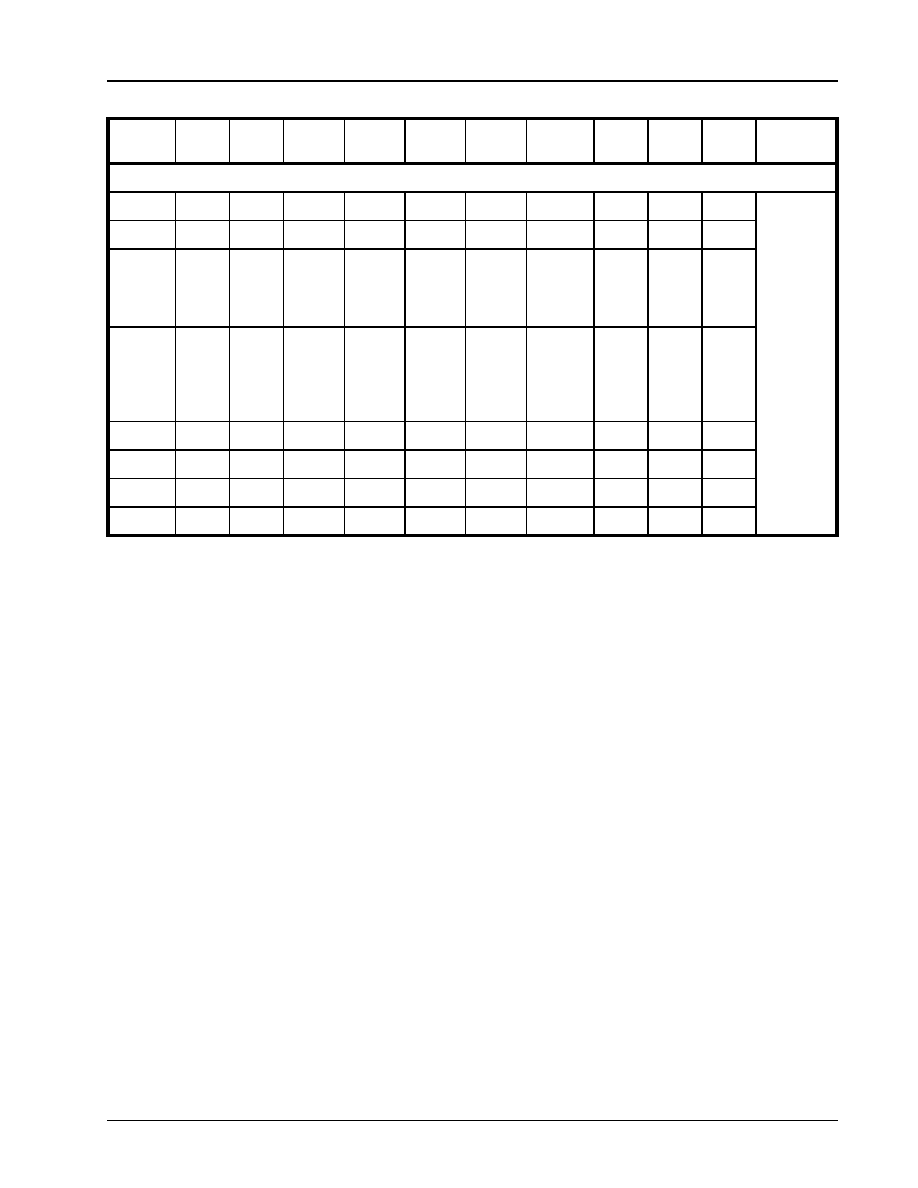
��
��
��
��
3.3V AND 5V DUART WITH 128-BYTE FIFO
XR16C2850
REV. 2.0.0
20
4.0
INTERNAL REGISTER DESCRIPTIONS
4.1
R
ECEIVE
H
OLDING
R
EGISTER
(RHR) - R
EAD
-
O
NLY
See "Receiver" on page 12.
4.2
T
RANSMIT
H
OLDING
R
EGISTER
(THR) - W
RITE
-
O
NLY
See "Transmitter" on page 11.
4.3
I
NTERRUPT
E
NABLE
R
EGISTER
(IER) - R
EAD
/
W
RITE
The Interrupt Enable Register (IER) masks the inter-
rupts from receive data ready, transmit empty, line
status and modem status registers. These interrupts
are reported in the Interrupt Status Register (ISR).
4.3.1
IER versus Receive FIFO Interrupt Mode
Operation
When the receive FIFO (FCR BIT-0 = 1) and receive
interrupts (IER BIT-0 = 1) are enabled, the RHR inter-
rupts (see ISR bits 2 and 3) status will reflect the fol-
lowing:
A. The receive data available interrupts are issued
to the host when the FIFO has reached the pro-
grammed trigger level. It will be cleared when the
FIFO drops below the programmed trigger level.
B. FIFO level will be reflected in the ISR register
when the FIFO trigger level is reached. Both the
ISR register status bit and the interrupt will be
cleared when the FIFO drops below the trigger
level.
C. The receive data ready bit (LSR BIT-0) is set as
soon as a character is transferred from the shift
register to the receive FIFO. It is reset when the
FIFO is empty.
4.3.2
IER versus Receive/Transmit FIFO Polled
Mode Operation
When FCR BIT-0 equals a logic 1 for FIFO enable; re-
setting IER bits 0-3 enables the XR16C2850 in the
FIFO polled mode of operation. Since the receiver
and transmitter have separate bits in the LSR either
or both can be used in the polled mode by selecting
respective transmit or receive control bit(s).
A. LSR BIT-0 indicates there is data in RHR
or
RX
FIFO.
B. LSR BIT-1 indicates an overrun error has oc-
curred and that data in the FIFO may not be valid.
C. LSR BIT 2-4 provides the type of receive data er-
rors encountered for the data byte in RHR, if any.
D. LSR BIT-5 indicates THR is empty.
E. LSR BIT-6 indicates when both the transmit FIFO
and TSR are empty.
F.
LSR BIT-7 indicates a data error in at least one
character in the RX FIFO.
Enhanced Registers
0 0 0
TRG
WR
Bit-7
Bit-6
Bit-5
Bit-4
Bit-3
Bit-2
Bit-1
Bit-0
LCR=0
X
BF
0 0 0
FC
RD
Bit-7
Bit-6
Bit-5
Bit-4
Bit-3
Bit-2
Bit-1
Bit-0
0 0 1
FCTR
RD/WR
RX/TX
Mode
SCPAD
Swap
Trig
Table
Bit-1
Trig
Table
Bit-0
Auto
RS485
Direction
Control
RX IR
Input
Inv.
Auto
RTS
Hyst Bit-
1
Auto
RTS
Hyst Bit-
0
0 1 0
EFR
RD/WR Auto CTS
Enable
Auto RTS
Enable
Special
Char
Select
Enable
IER [7:4],
ISR [5:4],
FCR[5:4],
MCR[7:5]
Soft-
ware
Flow
Cntl
Bit-3
Soft-
ware
Flow
Cntl
Bit-2
Soft-
ware
Flow
Cntl
Bit-1
Soft-
ware
Flow
Cntl
Bit-0
1 0 0
XON1
RD/WR
Bit-7
Bit-6
Bit-5
Bit-4
Bit-3
Bit-2
Bit-1
Bit-0
1 0 1
XON2
RD/WR
Bit-7
Bit-6
Bit-5
Bit-4
Bit-3
Bit-2
Bit-1
Bit-0
1 1 0
XOFF1 RD/WR
Bit-7
Bit-6
Bit-5
Bit-4
Bit-3
Bit-2
Bit-1
Bit-0
1 1 1
XOFF2 RD/WR
Bit-7
Bit-6
Bit-5
Bit-4
Bit-3
Bit-2
Bit-1
Bit-0
T
ABLE
8: INTERNAL REGISTERS DESCRIPTION.
S
HADED
BITS
ARE
ENABLED
WHEN
EFR B
IT
-4=1
A
DDRESS
A2-A0
R
EG
N
AME
R
EAD
/
W
RITE
B
IT
-7
B
IT
-6
B
IT
-5
B
IT
-4
B
IT
-3
B
IT
-2
B
IT
-1
B
IT
-0
C
OMMENT

XR16C2850
3.3V AND 5V DUART WITH 128-BYTE FIFO
��
��
��
��
REV. 2.0.0
21
IER[0]: RHR Interrupt Enable
The receive data ready interrupt will be issued when
RHR has a data character in the non-FIFO mode
or
when the receive FIFO has reached the programmed
trigger level in the FIFO mode.
� Logic 0 = Disable the receive data ready interrupt
(default).
� Logic 1 = Enable the receiver data ready interrupt.
IER[1]: THR Interrupt Enable
This bit enables the Transmit Ready interrupt which is
issued whenever the THR becomes empty in the non-
FIFO mode or when data in the FIFO falls below the
programmed trigger level in the FIFO mode. If the
THR is empty when this bit is enabled, an interrupt
will be generated.
� Logic 0 = Disable Transmit Ready interrupt
(default).
� Logic 1 = Enable Transmit Ready interrupt.
IER[2]: Receive Line Status Interrupt Enable
If any of the LSR register bits 1, 2, 3 or 4 is a logic 1,
it will generate an interrupt to inform the host control-
ler about the error status of the current data byte in
FIFO. LSR bits 1-4 generate an interrupt immediately
when the character has been received.
� Logic 0 = Disable the receiver line status interrupt
(default).
� Logic 1 = Enable the receiver line status interrupt.
IER[3]: Modem Status Interrupt Enable
� Logic 0 = Disable the modem status register inter-
rupt (default).
� Logic 1 = Enable the modem status register inter-
rupt.
IER[4]: Sleep Mode Enable (requires EFR bit-4 =
1)
� Logic 0 = Disable Sleep Mode (default).
� Logic 1 = Enable Sleep Mode. See Sleep Mode
section for further details.
IER[5]: Xoff Interrupt Enable (requires EFR bit-
4=1)
� Logic 0 = Disable the software flow control, receive
Xoff interrupt. (default)
� Logic 1 = Enable the software flow control, receive
Xoff interrupt. See Software Flow Control section
for details.
IER[6]: RTS# Output Interrupt Enable (requires
EFR bit-4=1)
� Logic 0 = Disable the RTS# interrupt (default).
� Logic 1 = Enable the RTS# interrupt. The UART
issues an interrupt when the RTS# pin makes a
transition from low to high.
IER[7]: CTS# Input Interrupt Enable (requires EFR
bit-4=1)
� Logic 0 = Disable the CTS# interrupt (default).
� Logic 1 = Enable the CTS# interrupt. The UART
issues an interrupt when CTS# pin makes a transi-
tion from low to high.
4.4
I
NTERRUPT
S
TATUS
R
EGISTER
(ISR) - R
EAD
-
O
NLY
The UART provides multiple levels of prioritized inter-
rupts to minimize external software interaction. The
Interrupt Status Register (ISR) provides the user with
six interrupt status bits. Performing a read cycle on
the ISR will give the user the current highest pending
interrupt level to be serviced, others are queued up to
be serviced next. No other interrupts are acknowl-
edged until the pending interrupt is serviced. The In-
terrupt Source Table, Table 9, shows the data values
(bit 0-5) for the interrupt priority levels and the inter-
rupt sources associated with each of these interrupt
levels.
4.4.1
Interrupt Generation:
� LSR is by any of the LSR bits 1, 2, 3 and 4.
� RXRDY is by RX trigger level.
� RXRDY Time-out is by a 4-char plus 12 bits delay
timer.
� TXRDY is by TX trigger level or TX FIFO empty (or
transmitter empty in auto RS-485 control).
� MSR is by any of the MSR bits 0, 1, 2 and 3.
� Receive Xoff/Special character is by detection of a
Xoff or Special character.
� CTS# is when its transmitter toggles the input pin
(from low to high) during auto CTS flow control
enabled by EFR bit-7.
� RTS# is when its receiver toggles the output pin
(from low to high) during auto RTS flow control
enabled by EFR bit-6.
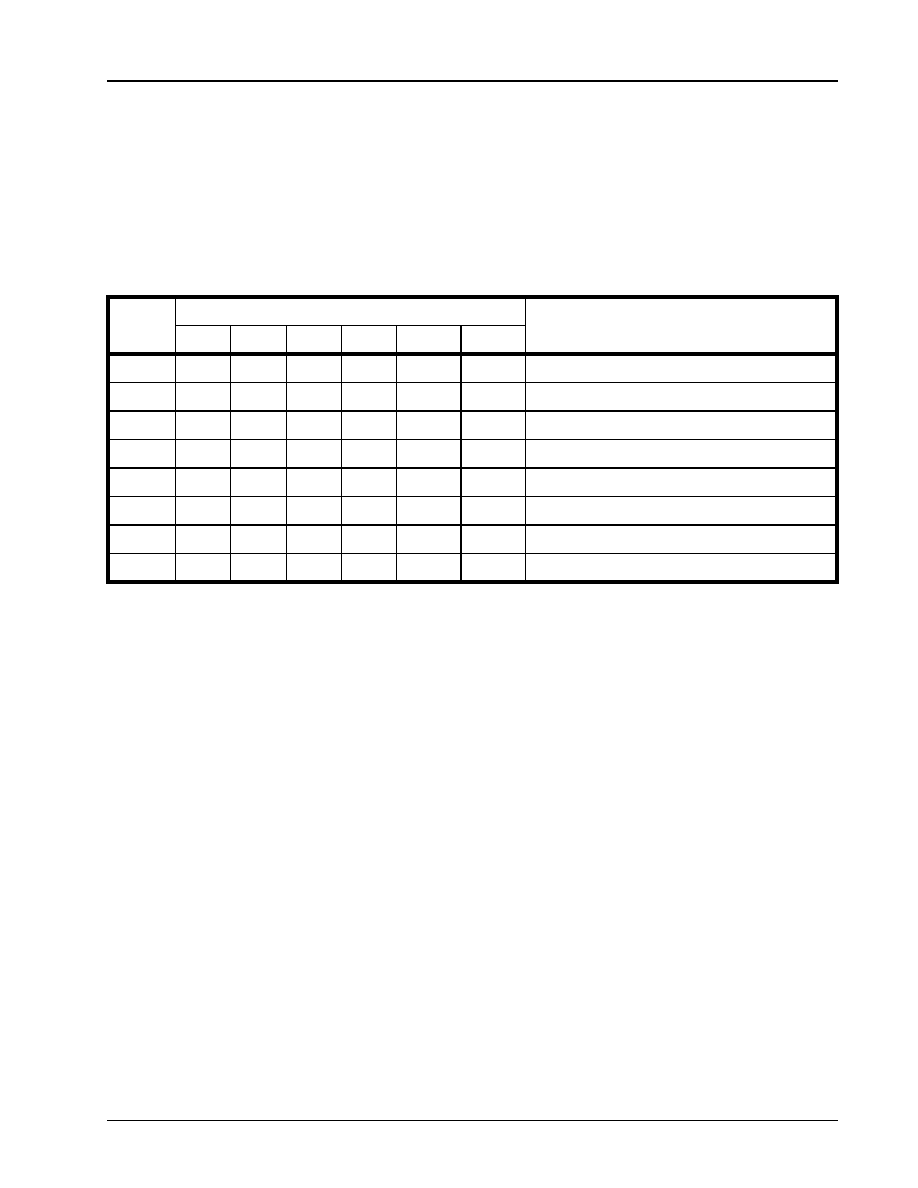
��
��
��
��
3.3V AND 5V DUART WITH 128-BYTE FIFO
XR16C2850
REV. 2.0.0
22
4.4.2
Interrupt Clearing:
� LSR interrupt is cleared by a read to the LSR regis-
ter (but flags and tags not cleared until character(s)
that generated the interrupt(s) has been emptied or
cleared from FIFO).
� RXRDY interrupt is cleared by reading data until
FIFO falls below the trigger level.
� RXRDY Time-out interrupt is cleared by reading
RHR.
� TXRDY interrupt is cleared by a read to the ISR
register or writing to THR.
� MSR interrupt is cleared by a read to the MSR reg-
ister.
� Xoff or Special character interrupt is cleared by a
read to ISR.
� RTS# and CTS# flow control interrupts are cleared
by a read to the MSR register.
ISR[0]: Interrupt Status
� Logic 0 = An interrupt is pending and the ISR con-
tents may be used as a pointer to the appropriate
interrupt service routine.
� Logic 1 = No interrupt pending (default condition).
ISR[3:1]: Interrupt Status
These bits indicate the source for a pending interrupt
at interrupt priority levels (See Interrupt Source
Table 9).
ISR[5:4]: Interrupt Status
These bits are enabled when EFR bit-4 is set to a log-
ic 1. ISR bit-4 indicates that the receiver detected a
data match of the Xoff character(s). Note that once
set to a logic 1, the ISR bit-4 will stay a logic 1 until a
Xon character is received. ISR bit-5 indicates that
CTS# or RTS# has changed state.
ISR[7:6]: FIFO Enable Status
These bits are set to a logic 0 when the FIFOs are
disabled. They are set to a logic 1 when the FIFOs
are enabled.
4.5
FIFO C
ONTROL
R
EGISTER
(FCR) - W
RITE
-O
NLY
This register is used to enable the FIFOs, clear the
FIFOs, set the transmit/receive FIFO trigger levels,
and select the DMA mode. The DMA, and FIFO
modes are defined as follows:
FCR[0]: TX and RX FIFO Enable
� Logic 0 = Disable the transmit and receive FIFO
(default).
� Logic 1 = Enable the transmit and receive FIFOs.
This bit must be set to logic 1 when other FCR bits
are written or they will not be programmed.
FCR[1]: RX FIFO Reset
This bit is only active when FCR bit-0 is a `1'.
� Logic 0 = No receive
FIFO
reset (default).
� Logic 1 = Reset the receive FIFO pointers and
FIFO level counter logic (the receive shift register is
not cleared or altered). This bit will return to a logic
0 after resetting the FIFO.
FCR[2]: TX FIFO Reset
This bit is only active when FCR bit-0 is a `1'.
� Logic 0 = No transmit FIFO reset (default).
� Logic 1 = Reset the transmit FIFO pointers and
FIFO level counter logic (the transmit shift register
is not cleared or altered). This bit will return to a
logic 0 after resetting the FIFO.
T
ABLE
9: I
NTERRUPT
S
OURCE
AND
P
RIORITY
L
EVEL
P
RIORITY
ISR R
EGISTER
S
TATUS
B
ITS
S
OURCE
OF
INTERRUPT
L
EVEL
B
IT
-5
B
IT
-4
B
IT
-3
B
IT
-2
B
IT
-1
B
IT
-0
1
0
0
0
1
1
0
LSR (Receiver Line Status Register)
2
0
0
1
1
0
0
RXRDY (Receive Data Time-out)
3
0
0
0
1
0
0
RXRDY (Received Data Ready)
4
0
0
0
0
1
0
TXRDY (Transmit Ready)
5
0
0
0
0
0
0
MSR (Modem Status Register)
6
0
1
0
0
0
0
RXRDY (Received Xoff or Special character)
7
1
0
0
0
0
0
CTS#, RTS# change of state
-
0
0
0
0
0
1
None (default)

XR16C2850
3.3V AND 5V DUART WITH 128-BYTE FIFO
��
��
��
��
REV. 2.0.0
23
FCR[3]: DMA Mode Select
Controls the behavior of the TXRDY# and RXRDY#
pins. See DMA operation section for details.
� Logic 0 = Normal Operation (default).
� Logic 1 = DMA Mode.
FCR[5:4]: Transmit FIFO Trigger Select
(logic 0 = default, TX trigger level = one)
These 2 bits set the trigger level for the transmit FIFO.
The UART will issue a transmit interrupt when the
number of characters in the FIFO falls below the se-
lected trigger level, or when it gets empty in case that
the FIFO did not get filled over the trigger level on last
re-load. Table 10
below shows the selections. EFR
bit-4 must be set to `1' before these bits can be ac-
cessed. Note that the receiver and the transmitter
cannot use different trigger tables. Whichever selec-
tion is made last applies to both the RX and TX side.
FCR[7:6]: Receive FIFO Trigger Select
(logic 0 = default, RX trigger level =1)
The FCTR Bits 5-4 are associated with these 2 bits.
These 2 bits are used to set the trigger level for the
receive FIFO. The UART will issue a receive interrupt
when the number of the characters in the FIFO cross-
es the trigger level. Table 10 shows the complete se-
lections.
N
OTE
: The receiver and the transmitter cannot use different
trigger tables. Whichever selection is made last applies to
both the RX and TX side.
T
ABLE
10: T
RANSMIT
AND
R
ECEIVE
FIFO T
RIGGER
L
EVEL
S
ELECTION
FCTR
B
IT
-5
FCTR
B
IT
-4
FCR
B
IT
-7
FCR
B
IT
-6
FCR
B
IT
-5
FCR
BIT
-4
R
ECEIVE
T
RIGGER
L
EVEL
T
RANSMIT
T
RIGGER
L
EVEL
C
OMPATIBILITY
0
0
0
0
1
1
0
1
0
1
0
0
1 (default)
4
8
14
1 (default)
Table-A. 16C550, 16C2550,
16C2552, 16C554, 16C580
compatible.
0
1
0
0
1
1
0
1
0
1
0
0
1
1
0
1
0
1
8
16
24
28
16
8
24
30
Table-B. 16C650A compatible.
1
0
0
0
1
1
0
1
0
1
0
0
1
1
0
1
0
1
8
16
56
60
8
16
32
56
Table-C. 16C654 compatible.
1
1
X
X
X
X
Programmable
via TRG
register.
FCTR[7] = 0.
Programmable
via TRG
register.
FCTR[7] = 1.
Table-D. 16C850, 16L2752,
16L2750, 16C2852, 16C854,
16C864, 16C872 compatible.
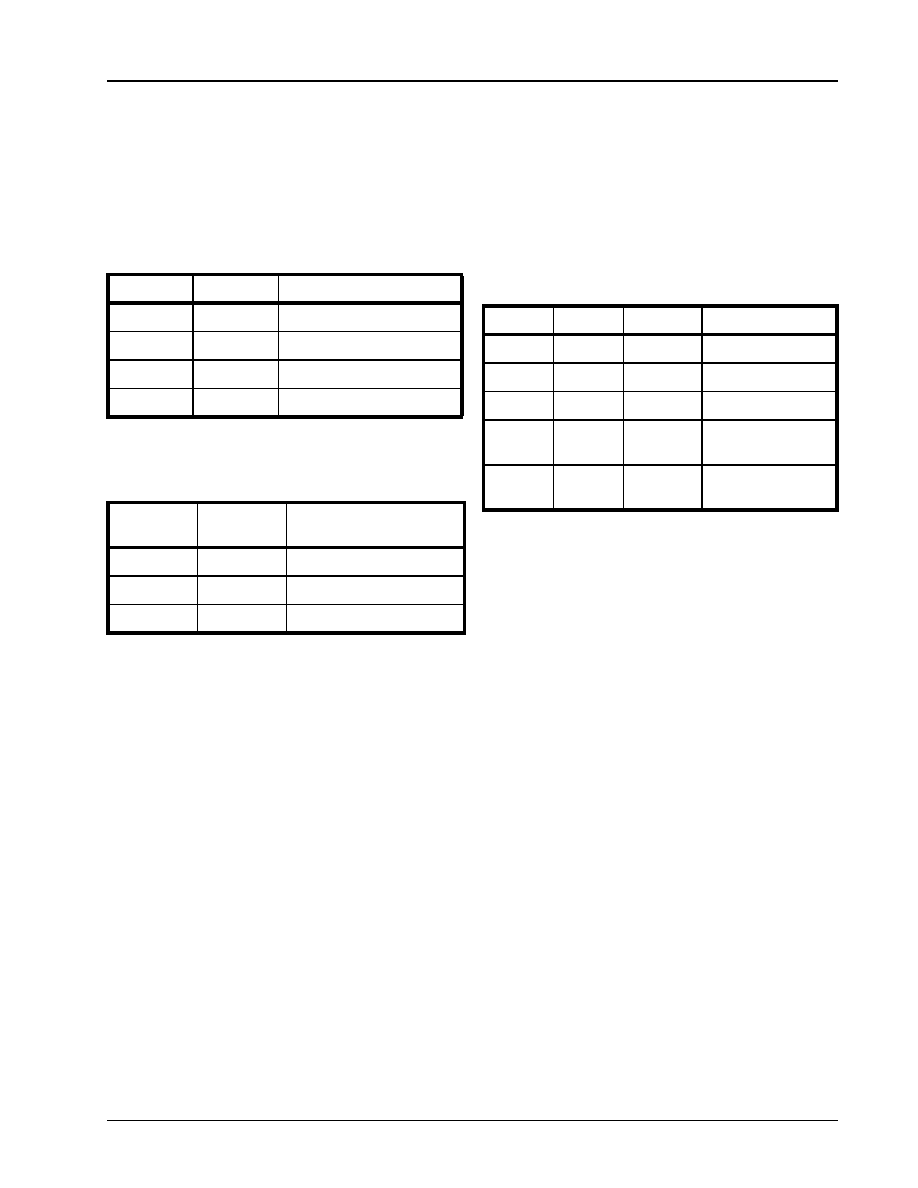
��
��
��
��
3.3V AND 5V DUART WITH 128-BYTE FIFO
XR16C2850
REV. 2.0.0
24
4.6
L
INE
C
ONTROL
R
EGISTER
(LCR) - R
EAD
/W
RITE
The Line Control Register is used to specify the asyn-
chronous data communication format. The word or
character length, the number of stop bits, and the par-
ity are selected by writing the appropriate bits in this
register.
LCR[1-0]: TX and RX Word Length Select
These two bits specify the word length to be transmit-
ted or received.
LCR[2]: TX and RX Stop-bit Length Select
The length of stop bit is specified by this bit in con-
junction with the programmed word length.
LCR[3]: TX and RX Parity Select
Parity or no parity can be selected via this bit. The
parity bit is a simple way used in communications for
data integrity check. See Table 11 for parity selection
summary below.
� Logic 0 = No parity.
� Logic 1 = A parity bit is generated during the trans-
mission while the receiver checks for parity error of
the data character received.
LCR[4]: TX and RX Parity Select
If the parity bit is enabled with LCR bit-3 set to a logic
1, LCR BIT-4 selects the even or odd parity format.
� Logic 0 = ODD Parity is generated by forcing an
odd number of logic 1's in the transmitted character.
The receiver must be programmed to check the
same format (default).
� Logic 1 = EVEN Parity is generated by forcing an
even number of logic 1's in the transmitted charac-
ter. The receiver must be programmed to check the
same format.
LCR[5]: TX and RX Parity Select
If the parity bit is enabled, LCR BIT-5 selects the
forced parity format.
� LCR BIT-5 = logic 0, parity is not forced (default).
� LCR BIT-5 = logic 1 and LCR BIT-4 = logic 0, parity
bit is forced to a logical 1 for the transmit and
receive data.
LCR[6]: Transmit Break Enable
When enabled, the Break control bit causes a break
condition to be transmitted (the TX output is forced to
a "space', logic 0, state). This condition remains, until
disabled by setting LCR bit-6 to a logic 0.
� Logic 0 = No TX break condition. (default)
� Logic 1 = Forces the transmitter output (TX) to a
"space", logic 0, for alerting the remote receiver of a
line break condition.
LCR[7]: Baud Rate Divisors Enable
� Logic 0 = Data registers are selected (default).
� Logic 1 = Divisor latch registers are selected.
4.7
M
ODEM
C
ONTROL
R
EGISTER
(MCR)
OR
G
EN
-
ERAL
P
URPOSE
O
UTPUTS
C
ONTROL
- R
EAD
/
W
RITE
The MCR register is used for controlling the serial/
modem interface signals or general purpose inputs/
outputs.
MCR[0]: DTR# Output
The DTR# pin is a modem control output. If the mo-
dem interface is not used, this output may be used as
a general purpose output.
� Logic 0 = Force DTR# output to a logic 1 (default).
� Logic 1 = Force DTR# output to a logic 0.
BIT-1
BIT-0
W
ORD
LENGTH
0
0
5 (default)
0
1
6
1
0
7
1
1
8
BIT-2
W
ORD
LENGTH
S
TOP
BIT
LENGTH
(B
IT
TIME
(
S
))
0
5,6,7,8
1 (default)
1
5
1-1/2
1
6,7,8
2
T
ABLE
11: P
ARITY
SELECTION
LCR B
IT
-5 LCR B
IT
-4 LCR B
IT
-3
P
ARITY
SELECTION
X
X
0
No parity
0
0
1
Odd parity
0
1
1
Even parity
1
0
1
Force parity to mark,
"1"
1
1
1
Forced parity to
space, "0"

XR16C2850
3.3V AND 5V DUART WITH 128-BYTE FIFO
��
��
��
��
REV. 2.0.0
25
MCR[1]: RTS# Output
The RTS# pin is a modem control output and may be
used for automatic hardware flow control by enabled
by EFR bit-6. If the modem interface is not used, this
output may be used as a general purpose output.
� Logic 0 = Force RTS# output to a logic 1 (default).
� Logic 1 = Force RTS# output to a logic 0.
MCR[2]: Reserved
OP1# is not available as an output pin on the 2850.
But it is available for use during Internal Loopback
Mode. In the Loopback Mode, this bit is used to write
the state of the modem RI# interface signal.
MCR[3]: OP2# Output / INT Output Enable
This bit enables and disables the operation of INT, in-
terrupt output. If INT output is not used, OP2# can be
used as a general purpose output.
� Logic 0 = INT (A-B) outputs disabled (three state
mode) and OP2# output set to a logic 1 (default).
� Logic 1 = INT (A-B) outputs enabled (active mode)
and OP2# output set to a logic 0.
MCR[4]: Internal Loopback Enable
� Logic 0 = Disable loopback mode (default).
� Logic 1 = Enable local loopback mode, see loop-
back section and Figure 13.
MCR[5]: Xon-Any Enable
� Logic 0 = Disable Xon-Any function (for 16C550
compatibility, default).
� Logic 1 = Enable Xon-Any function. In this mode,
any RX character received will resume transmit
operation. The RX character will be loaded into the
RX FIFO , unless the RX character is an Xon or
Xoff character and the 2850 is programmed to use
the Xon/Xoff flow control.
MCR[6]: Infrared Encoder/Decoder Enable
� Logic 0 = Enable the standard modem receive and
transmit input/output interface. (Default)
� Logic 1 = Enable infrared IrDA receive and transmit
inputs/outputs. The TX/RX output/input are routed
to the infrared encoder/decoder. The data input and
output levels conform to the IrDA infrared interface
requirement. While in this mode, the infrared TX
output will be a logic 0 during idle data conditions.
MCR[7]: Clock Prescaler Select
� Logic 0 = Divide by one. The input clock from the
crystal or external clock is fed directly to the Pro-
grammable Baud Rate Generator without further
modification, i.e., divide by one (default).
� Logic 1 = Divide by four. The prescaler divides the
input clock from the crystal or external clock by four
and feeds it to the Programmable Baud Rate Gen-
erator, hence, data rates become one forth.
4.8
L
INE
S
TATUS
R
EGISTER
(LSR) - R
EAD
O
NLY
This register provides the status of data transfers be-
tween the UART and the host. If IER bit-2 is set to a
logic 1, an LSR interrupt will be generated immediate-
ly when any character in the RX FIFO has an error
(parity, framing, overrun, break).
LSR[0]: Receive Data Ready Indicator
� Logic 0 = No data in receive holding register or
FIFO (default).
� Logic 1 = Data has been received and is saved in
the receive holding register or FIFO.
LSR[1]: Receiver Overrun Error Flag
� Logic 0 = No overrun error (default).
� Logic 1 = Overrun error. A data overrun error condi-
tion occurred in the receive shift register. This hap-
pens when additional data arrives while the FIFO is
full. In this case the previous data in the receive
shift register is overwritten. Note that under this
condition the data byte in the receive shift register
is not transferred into the FIFO, therefore the data
in the FIFO is not corrupted by the error. If IER bit-
2 is set, an interrupt will be generated immediately.
LSR[2]: Receive Data Parity Error Tag
� Logic 0 = No parity error (default).
� Logic 1 = Parity error. The receive character in RHR
does not have correct parity information and is sus-
pect. This error is associated with the character
available for reading in RHR.
LSR[3]: Receive Data Framing Error Tag
� Logic 0 = No framing error (default).
� Logic 1 = Framing error. The receive character did
not have a valid stop bit(s). This error is associated
with the character available for reading in RHR.
LSR[4]: Receive Break Error Tag
� Logic 0 = No break condition (default).
� Logic 1 = The receiver received a break signal (RX
was a logic 0 for at least one character frame time).
In the FIFO mode, only one break character is
loaded into the FIFO. The break indication remains
until the RX input returns to the idle condition,
"mark" or logic 1.

��
��
��
��
3.3V AND 5V DUART WITH 128-BYTE FIFO
XR16C2850
REV. 2.0.0
26
LSR[5]: Transmit Holding Register Empty Flag
This bit is the Transmit Holding Register Empty indi-
cator. The THR bit is set to a logic 1 when the last da-
ta byte is transferred from the transmit holding regis-
ter to the transmit shift register. The bit is reset to log-
ic 0 concurrently with the data loading to the transmit
holding register by the host. In the FIFO mode this bit
is set when the transmit FIFO is empty, it is cleared
when the transmit FIFO contains at least 1 byte.
LSR[6]: THR and TSR Empty Flag
This bit is set to a logic 1 whenever the transmitter
goes idle. It is set to logic 0 whenever either the THR
or TSR contains a data character. In the FIFO mode
this bit is set to a logic 1 whenever the transmit FIFO
and transmit shift register are both empty.
LSR[7]: Receive FIFO Data Error Flag
� Logic 0 = No FIFO error (default).
� Logic 1 = A global indicator for the sum of all error
bits in the RX FIFO. At least one parity error, fram-
ing error or break indication is in the FIFO data.
This bit clears when there is no more error(s) in any
of the bytes in the RX FIFO.
4.9
M
ODEM
S
TATUS
R
EGISTER
(MSR) - R
EAD
O
NLY
This register provides the current state of the modem
interface input signals. Lower four bits of this register
are used to indicate the changed information. These
bits are set to a logic 1 whenever a signal from the
modem changes state. These bits may be used for
general purpose inputs when they are not used with
modem signals.
MSR[0]: Delta CTS# Input Flag
� Logic 0 = No change on CTS# input (default).
� Logic 1 = The CTS# input has changed state since
the last time it was monitored. A modem status
interrupt will be generated if MSR interrupt is
enabled (IER bit-3).
MSR[1]: Delta DSR# Input Flag
� Logic 0 = No change on DSR# input (default).
� Logic 1 = The DSR# input has changed state since
the last time it was monitored. A modem status
interrupt will be generated if MSR interrupt is
enabled (IER bit-3).
MSR[2]: Delta RI# Input Flag
� Logic 0 = No change on RI# input (default).
� Logic 1 = The RI# input has changed from a logic 0
to a logic 1, ending of the ringing signal. A modem
status interrupt will be generated if MSR interrupt is
enabled (IER bit-3).
MSR[3]: Delta CD# Input Flag
� Logic 0 = No change on CD# input (default).
� Logic 1 = Indicates that the CD# input has changed
state since the last time it was monitored. A modem
status interrupt will be generated if MSR interrupt is
enabled (IER bit-3).
MSR[4]: CTS Input Status
CTS# pin may function as automatic hardware flow
control signal input if it is enabled and selected by Au-
to CTS (EFR bit-7). Auto CTS flow control allows
starting and stopping of local data transmissions
based on the modem CTS# signal. A logic 1 on the
CTS# pin will stop UART transmitter as soon as the
current character has finished transmission, and a
logic 0 will resume data transmission. Normally MSR
bit-4 bit is the compliment of the CTS# input. However
in the loopback mode, this bit is equivalent to the
RTS# bit in the MCR register. The CTS# input may be
used as a general purpose input when the modem in-
terface is not used.
MSR[5]: DSR Input Status
DSR#
(active high, logical 1). Normally this bit is the
compliment of the DSR# input. In the loopback mode,
this bit is equivalent to the DTR# bit in the MCR regis-
ter. The DSR# input may be used as a general pur-
pose input when the modem interface is not used.
MSR[6]: RI Input Status
RI# (active high, logical 1). Normally this bit is the
compliment of the RI# input. In the loopback mode
this bit is equivalent to bit-2 in the MCR register. The
RI# input may be used as a general purpose input
when the modem interface is not used.
MSR[7]: CD Input Status
CD# (active high, logical 1). Normally this bit is the
compliment of the CD# input. In the loopback mode
this bit is equivalent to bit-3 in the MCR register. The
CD# input may be used as a general purpose input
when the modem interface is not used.
4.10 S
CRATCH
P
AD
R
EGISTER
(SPR) - R
EAD
/W
RITE
This is a 8-bit general purpose register for the user to
store temporary data. The content of this register is
preserved during sleep mode but becomes 0xFF (de-
fault) after a reset or a power off-on cycle.
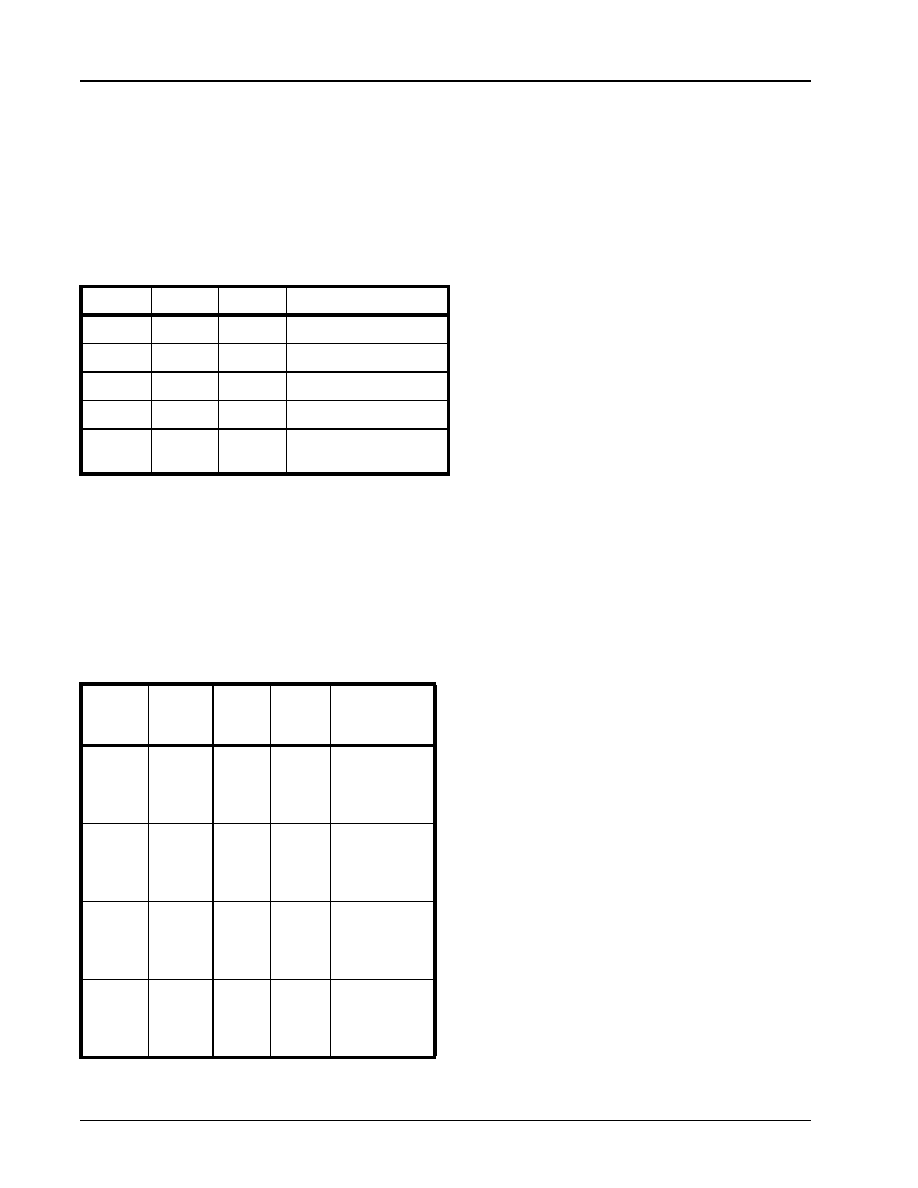
XR16C2850
3.3V AND 5V DUART WITH 128-BYTE FIFO
��
��
��
��
REV. 2.0.0
27
4.11 E
NHANCED
M
ODE
S
ELECT
R
EGISTER
(EMSR)
This register replaces SPR (during a Write) and is ac-
cessible only when FCTR[6] = 1.
EMSR[1:0]: Receive/Transmit FIFO Count (Write-
Only)
When Scratchpad Swap (FCTR[6]) is asserted, EM-
SR bits 1-0 controls what mode the FIFO Level
Counter is operating in.
During Alternate RX/TX FIFO Counter Mode, the first
value read after EMSR bits 1-0 have been asserted
will always be the RX FIFO Counter. The second val-
ue read will correspond with the TX FIFO Counter.
The next value will be the RX FIFO Counter again,
then the TX FIFO Counter and so on and so forth.
EMSR[3:2]: Reserved
EMSR[5:4]: Extended RTS Hysteresis
EMSR[7:6]: Reserved
4.12 FIFO L
EVEL
R
EGISTER
(FLVL) - R
EAD
-O
NLY
The FIFO Level Register replaces the Scratchpad
Register (during a Read) when FCTR[6] = 1. Note
that this is not identical to the FIFO Data Count Reg-
ister which can be accessed when LCR = 0xBF.
FLVL[7:0]: FIFO Level Register
This register provides the FIFO counter level for the
RX FIFO or the TX FIFO or both depending on EM-
SR[1:0]. See Table 12 for details.
4.13 B
AUD
R
ATE
G
ENERATOR
R
EGISTERS
(DLL
AND
DLM) - R
EAD
/W
RITE
The concatenation of the contents of DLM and DLL
gives the 16-bit divisor value which is used to calcu-
late the baud rate:
� Baud Rate = (Clock Frequency / 16) / Divisor
See MCR bit-7 and the baud rate table also.
4.14 D
EVICE
I
DENTIFICATION
R
EGISTER
(DVID) - R
EAD
O
NLY
This register contains the device ID (0x12 for
XR16C2850). Prior to reading this register, DLL and
DLM should be set to 0x00.
4.15 D
EVICE
R
EVISION
R
EGISTER
(DREV) - R
EAD
O
NLY
This register contains the device revision information.
For example, 0x01 means revision A. Prior to reading
this register, DLL and DLM should be set to 0x00.
4.16 T
RIGGER
L
EVEL
/ FIFO D
ATA
C
OUNT
R
EGISTER
(TRG) - W
RITE
-O
NLY
User Programmable Transmit/Receive Trigger Level
Register.
TRG[7:0]: Trigger Level Register
These bits are used to program desired trigger levels
when trigger Table-D is selected. FCTR bit-7 selects
between programming the RX Trigger Level (a logic
0) and the TX Trigger Level (a logic 1).
4.17 FIFO D
ATA
C
OUNT
R
EGISTER
(FC) - R
EAD
-O
NLY
This register is accessible when LCR = 0xBF. Note
that this register is not identical to the FIFO Level
Register which is located in the general register set
when FCTR bit-6 = 1.
FC[7:0]: FIFO Data Count Register
Transmit/Receive FIFO Count. Number of characters
in Transmit (FCTR[7] = 1) or Receive FIFO (FCTR[7]
= 0) can be read via this register.
T
ABLE
12: S
CRATCHPAD
S
WAP
S
ELECTION
FCTR[6]
EMSR[1]
EMSR[0]
Scratchpad is
0
X
X
Scratchpad
1
0
0
RX FIFO Counter Mode
1
0
1
TX FIFO Counter Mode
1
1
0
RX FIFO Counter Mode
1
1
1
Alternate RX/TX FIFO
Counter Mode
T
ABLE
13: A
UTO
RTS H
YSTERESIS
EMSR
B
IT
-5
EMSR
B
IT
-4
FCTR
B
IT
-1
FCTR
B
IT
-0
RTS#
H
YSTERESIS
(C
HARACTERS
)
0
0
0
0
0
0
0
0
0
0
1
1
0
1
0
1
0
�4
�6
�8
0
0
0
0
1
1
1
1
0
0
1
1
0
1
0
1
�8
�16
�24
�32
1
1
1
1
0
0
0
0
0
0
1
1
0
1
0
1
�40
�44
�48
�52
1
1
1
1
1
1
1
1
0
0
1
1
0
1
0
1
�12
�20
�28
�36
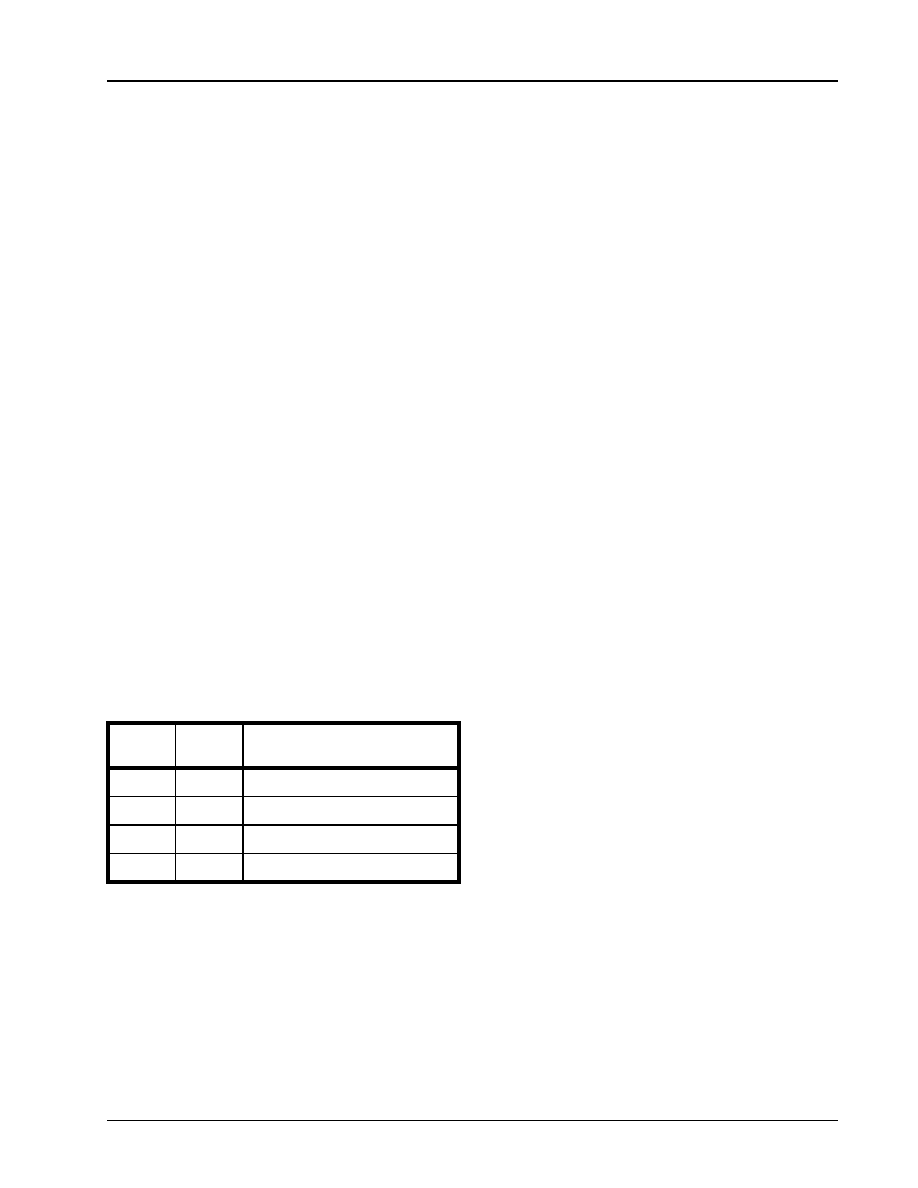
��
��
��
��
3.3V AND 5V DUART WITH 128-BYTE FIFO
XR16C2850
REV. 2.0.0
28
4.18 F
EATURE
C
ONTROL
R
EGISTER
(FCTR) - R
EAD
/
W
RITE
This register controls the XR16C2850 new functions
that are not available in ST16C550 or ST16C650A.
FCTR[1:0]: RTS Hysteresis
User selectable RTS# hysteresis levels for hardware
flow control application. After reset, these bits are set
to "0" to select the next trigger level for hardware flow
control. See Table 13 on page 27 for more details.
FCTR[2]: IrDa RX Inversion
� Logic 0 = Select RX input as encoded IrDa data
(Idle state will be logic 0).
� Logic 1 = Select RX input as inverted encoded IrDa
data (Idle state will be logic 1).
FCTR[3]: Auto RS-485 Direction Control
� Logic 0 = Standard ST16C550 mode. Transmitter
generates an interrupt when transmit holding regis-
ter becomes empty and transmit shift register is
shifting data out.
� Logic 1 = Enable Auto RS485 Direction Control
function. The direction control signal, RTS# pin,
changes its output logic state from low to high one
bit time after the last stop bit of the last character is
shifted out. Also, the Transmit interrupt generation
is delayed until the transmitter shift register
becomes empty. The RTS# output pin will automat-
ically return to a logic low when a data byte is
loaded into the TX FIFO.
FCTR[5:4]: Transmit/Receive Trigger Table Select
See Table 10 on page 23 for more details.
FCTR[6]: Scratchpad Swap
� Logic 0 = Scratch Pad register is selected as gen-
eral read and write register. ST16C550 compatible
mode.
� Logic 1 = FIFO Count register (Read-Only),
Enhanced Mode Select Register (Write-Only).
Number of characters in transmit or receive FIFO
can be read via scratch pad register when this bit is
set. Enhanced Mode Select Register is selected
when it is written into.
FCTR[7]: Programmable Trigger Register Select
� Logic 0 = Registers TRG and FC selected for RX.
� Logic 1 = Registers TRG and FC selected for TX.
4.19 E
NHANCED
F
EATURE
R
EGISTER
(EFR)
Enhanced features are enabled or disabled using this
register. Bit 0-3 provide single or dual consecutive
character software flow control selection (see
Table 15). When the Xon1 and Xon2 and Xoff1 and
Xoff2 modes are selected, the double 8-bit words are
concatenated into two sequential characters. Cau-
tion: note that whenever changing the TX or RX flow
control bits, always reset all bits back to logic 0 (dis-
able) before programming a new setting.
EFR[3:0]: Software Flow Control Select
Single character and dual sequential characters soft-
ware flow control is supported. Combinations of soft-
ware flow control can be selected by programming
these bits.
T
ABLE
14: T
RIGGER
T
ABLE
S
ELECT
FCTR
B
IT
-5
FCTR
B
IT
-4
T
ABLE
0
0
Table-A (TX/RX)
0
1
Table-B (TX/RX)
1
0
Table-C (TX/RX)
1
1
Table-D (TX/RX)

XR16C2850
3.3V AND 5V DUART WITH 128-BYTE FIFO
��
��
��
��
REV. 2.0.0
29
EFR[4]: Enhanced Function Bits Enable
Enhanced function control bit. This bit enables IER
bits 4-7, ISR bits 4-5, FCR bits 4-5, and MCR bits 5-7
to be modified. After modifying any enhanced bits,
EFR bit-4 can be set to a logic 0 to latch the new val-
ues. This feature prevents legacy software from alter-
ing or overwriting the enhanced functions once set.
Normally, it is recommended to leave it enabled, logic
1.
� Logic 0 = modification disable/latch enhanced fea-
tures. IER bits 4-7, ISR bits 4-5, FCR bits 4-5, and
MCR bits 5-7 are saved to retain the user settings.
After a reset, the IER bits 4-7, ISR bits 4-5, FCR
bits 4-5, and MCR bits 5-7are set to a logic 0 to be
compatible with ST16C550 mode (default).
� Logic 1 = Enables the above-mentioned register
bits to be modified by the user.
EFR[5]: Special Character Detect Enable
� Logic 0 = Special Character Detect Disabled
(default).
� Logic 1 = Special Character Detect Enabled. The
UART compares each incoming receive character
with data in Xoff-2 register. If a match exists, the
receive data will be transferred to FIFO and ISR bit-
4 will be set to indicate detection of the special
character. Bit-0 corresponds with the LSB bit of the
receive character. If flow control is set for compar-
ing Xon1, Xoff1 (EFR [1:0]= `10') then flow control
and special character work normally. However, if
flow control is set for comparing Xon2, Xoff2
(EFR[1:0]= `01') then flow control works normally,
but Xoff2 will not go to the FIFO, and will generate
an Xoff interrupt and a special character interrupt, if
enabled via IER bit-5.
EFR[6]: Auto RTS Flow Control Enable
RTS# output may be used for hardware flow control
by setting EFR bit-6 to logic 1. When Auto RTS is se-
lected, an interrupt will be generated when the re-
ceive FIFO is filled to the programmed trigger level
and RTS de-asserts to a logic 1 at the next upper trig-
ger level or hysteresis level. RTS# will return to a logic
0 when FIFO data falls below the next lower trigger
level. The RTS# output must be asserted (logic 0) be-
fore the auto RTS can take effect. RTS# pin will func-
tion as a general purpose output when hardware flow
control is disabled.
� Logic 0 = Automatic RTS flow control is disabled
(default).
� Logic 1 = Enable Automatic RTS flow control.
T
ABLE
15: S
OFTWARE
F
LOW
C
ONTROL
F
UNCTIONS
EFR
BIT
-3
C
ONT
-3
EFR
BIT
-2
C
ONT
-2
EFR
BIT
-1
C
ONT
-1
EFR
BIT
-0
C
ONT
-0
T
RANSMIT
AND
R
ECEIVE
S
OFTWARE
F
LOW
C
ONTROL
0
0
0
0
No TX and RX flow control (default and reset)
0
0
X
X
No transmit flow control
1
0
X
X
Transmit Xon1, Xoff1
0
1
X
X
Transmit Xon2, Xoff2
1
1
X
X
Transmit Xon1 and Xon2, Xoff1 and Xoff2
X
X
0
0
No receive flow control
X
X
1
0
Receiver compares Xon1, Xoff1
X
X
0
1
Receiver compares Xon2, Xoff2
1
0
1
1
Transmit Xon1, Xoff1
Receiver compares Xon1 or Xon2, Xoff1 or Xoff2
0
1
1
1
Transmit Xon2, Xoff2
Receiver compares Xon1 or Xon2, Xoff1 or Xoff2
1
1
1
1
Transmit Xon1 and Xon2, Xoff1 and Xoff2,
Receiver compares Xon1 and Xon2, Xoff1 and Xoff2
0
0
1
1
No transmit flow control,
Receiver compares Xon1 and Xon2, Xoff1 and Xoff2

��
��
��
��
3.3V AND 5V DUART WITH 128-BYTE FIFO
XR16C2850
REV. 2.0.0
30
EFR[7]: Auto CTS Flow Control Enable
Automatic CTS Flow Control.
� Logic 0 = Automatic CTS flow control is disabled
(default).
� Logic 1 = Enable Automatic CTS flow control. Data
transmission stops when CTS# input de-asserts to
logic 1. Data transmission resumes when CTS#
returns to a logic 0.
4.20 S
OFTWARE
F
LOW
C
ONTROL
R
EGISTERS
(XOFF1,
XOFF2, XON1, XON2) - R
EAD
/W
RITE
These registers are used as the programmable soft-
ware flow control characters xoff1, xoff2, xon1, and
xon2. For more details, see Table 6 on page 15.
T
ABLE
16: UART RESET CONDITIONS FOR
CHANNEL A AND B
REGISTERS
RESET STATE
DLL
Bits 7-0 = 0xXX
DLM
Bits 7-0 = 0xXX
RHR
Bits 7-0 = 0xXX
THR
Bits 7-0 = 0xXX
IER
Bits 7-0 = 0x00
FCR
Bits 7-0 = 0x00
ISR
Bits 7-0 = 0x01
LCR
Bits 7-0 = 0x00
MCR
Bits 7-0 = 0x00
LSR
Bits 7-0 = 0x60
MSR
Bits 3-0 = Logic 0
Bits 7-4 = Logic levels of the inputs
inverted
SPR
Bits 7-0 = 0xFF
EMSR
Bits 7-0 = 0x00
FLVL
Bits 7-0 = 0x00
EFR
Bits 7-0 = 0x00
XON1
Bits 7-0 = 0x00
XON2
Bits 7-0 = 0x00
XOFF1
Bits 7-0 = 0x00
XOFF2
Bits 7-0 = 0x00
FC
Bits 7-0 = 0x00
I/O SIGNALS
RESET STATE
TX
Logic 1
OP2#
Logic 1
RTS#
Logic 1
DTR#
Logic 1
RXRDY#
Logic 1
TXRDY#
Logic 0
INT
Three-State Condition
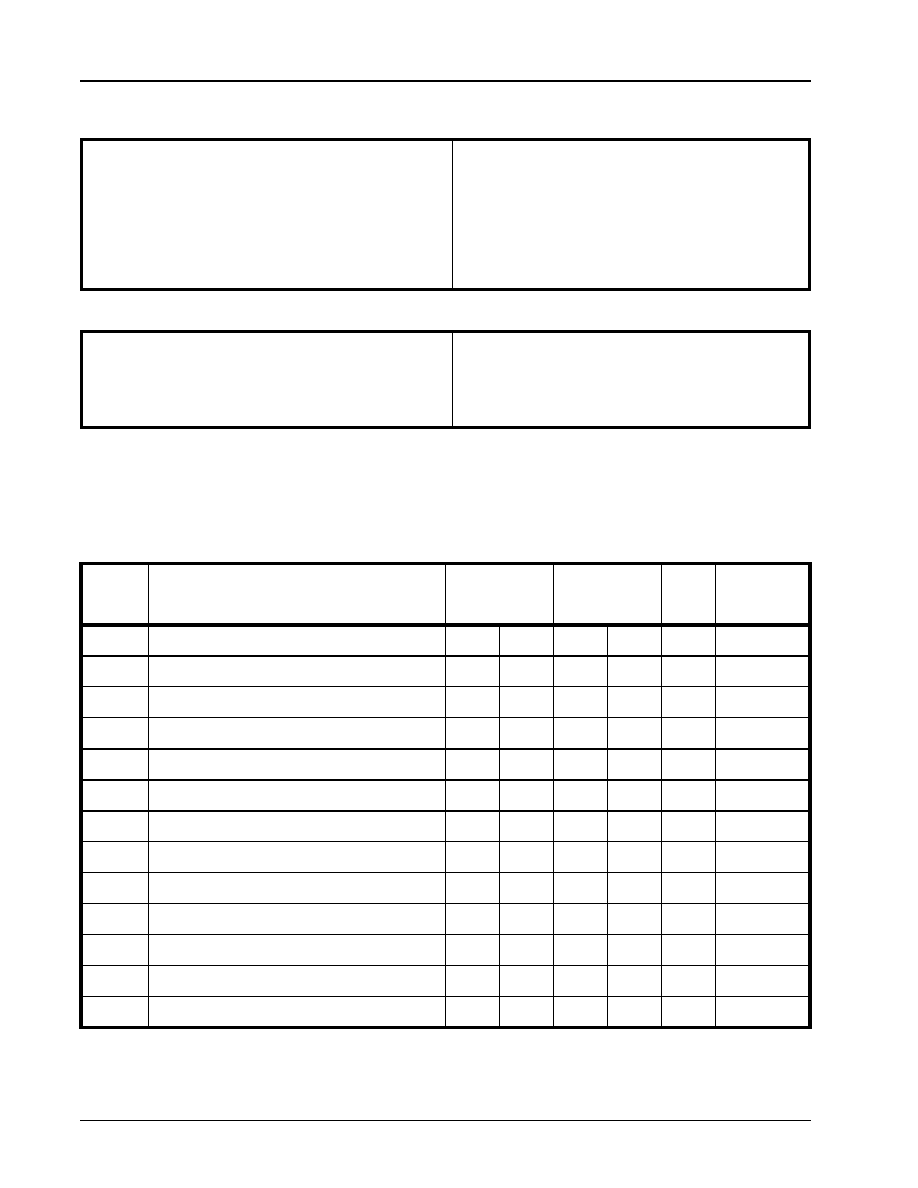
XR16C2850
3.3V AND 5V DUART WITH 128-BYTE FIFO
��
��
��
��
REV. 2.0.0
31
Test 1: The following inputs should remain steady at VCC or GND state to minimize Sleep current: A0-A2, D0-D7, IOR#,
IOW#, CSA# and CSB#. Also, RXA and RXB inputs must idle at logic 1 state while asleep.
ABSOLUTE MAXIMUM RATINGS
Power Supply Range
7 Volts
Voltage at Any Pin
GND-0.3 V to 7 V
Operating Temperature
-40
o
to +85
o
C
Storage Temperature
-65
o
to +150
o
C
Package Dissipation
500 mW
TYPICAL PACKAGE THERMAL RESISTANCE DATA
(MARGIN OF ERROR: � 15%)
Thermal Resistance (40-PDIP)
theta-ja =50
o
C/W, theta-jc = 22
o
C/W
Thermal Resistance (48-TQFP)
theta-ja =59
o
C/W, theta-jc = 16
o
C/W
Thermal Resistance (44-PLCC)
theta-ja = 50
o
C/W, theta-jc = 21
o
C/W
ELECTRICAL CHARACTERISTICS
DC ELECTRICAL CHARACTERISTICS
U
NLESS
OTHERWISE
NOTED
: TA=0
O
TO
70
O
C (-40
O
TO
+85
O
C
FOR
INDUSTRIAL
GRADE
PACKAGE
), V
CC
IS
3.3V,
5.0V �10%
S
YMBOL
P
ARAMETER
L
IMITS
3.3V
M
IN
M
AX
L
IMITS
5.0V
M
IN
M
AX
U
NITS
C
ONDITIONS
V
ILCK
Clock Input Low Level
-0.3
0.6
-0.5
0.6
V
V
IHCK
Clock Input High Level
2.4
VCC
3.0
VCC
V
V
IL
Input Low Voltage
-0.3
0.8
-0.5
0.8
V
V
IH
Input High Voltage
2.0
VCC
2.2
VCC
V
V
OL
Output Low Voltage
0.4
V
I
OL
= 6 mA
V
OL
Output Low Voltage
0.4
V
I
OL
= 4 mA
V
OH
Output High Voltage
2.4
V
I
OH
= -6 mA
V
OH
Output High Voltage
2.0
V
I
OH
= -1 mA
I
IL
Input Low Leakage Current
�10
�10
uA
I
IH
Input High Leakage Current
�10
�10
uA
C
IN
Input Pin Capacitance
5
5
pF
I
CC
Power Supply Current
1.2
3
mA
I
SLEEP
Sleep Current
30
100
uA
See Test 1
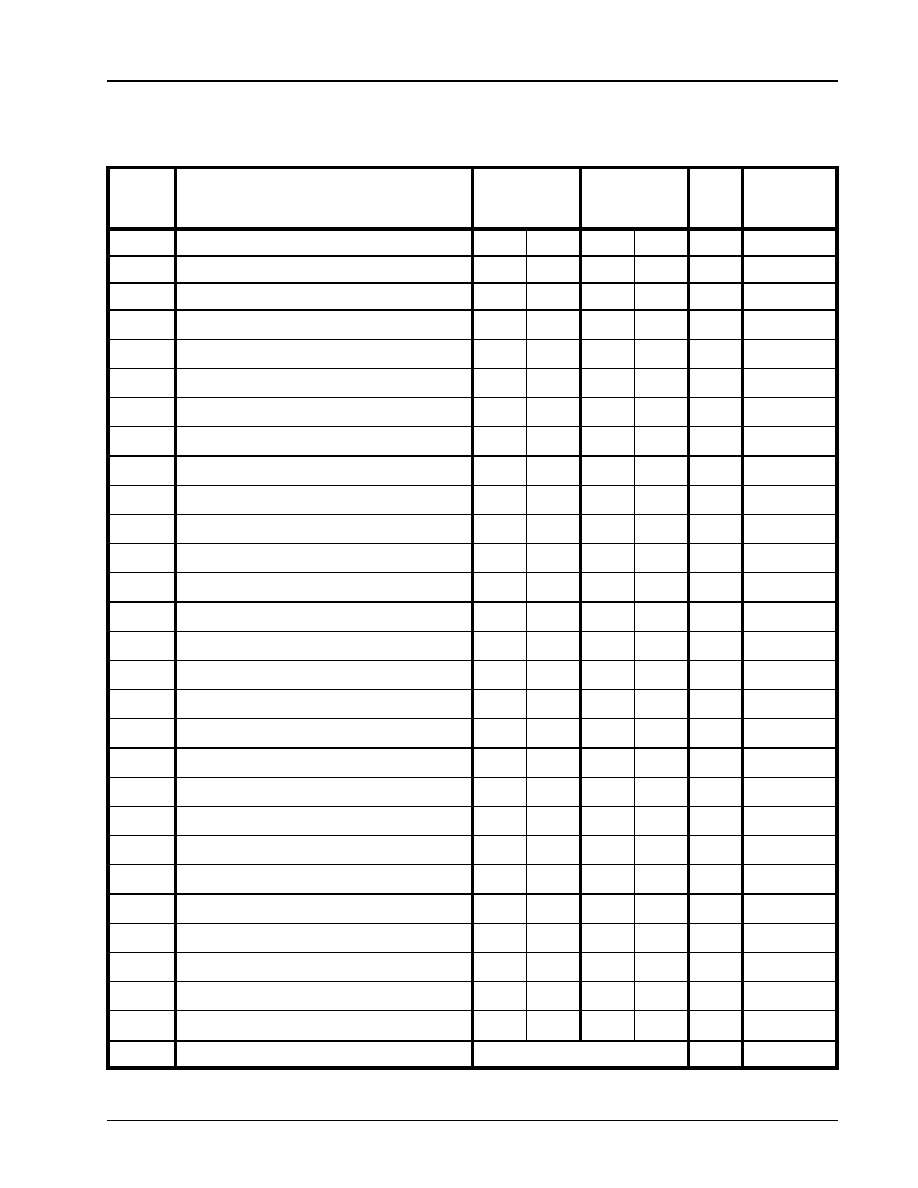
��
��
��
��
3.3V AND 5V DUART WITH 128-BYTE FIFO
XR16C2850
REV. 2.0.0
32
AC ELECTRICAL CHARACTERISTICS
TA=0
O
TO
70
O
C (-40
O
TO
+85
O
C
FOR
INDUSTRIAL
GRADE
PACKAGE
), V
CC
IS
3.3
OR
5.0V �10%
S
YMBOL
P
ARAMETER
L
IMITS
3.3V
M
IN
M
AX
L
IMITS
5.0V
M
IN
M
AX
U
NIT
C
ONDITIONS
CLK
Clock Pulse Duration
17
17
ns
OSC
Oscillator Frequency
8
24
MHz
OSC
External Clock Frequency
33
50
MHz
T
AS
Address Setup Time
5
0
ns
T
AH
Address Hold Time
10
5
ns
T
CS
Chip Select Width
66
50
ns
T
RD
IOR# Strobe Width
35
25
ns
T
DY
Read Cycle Delay
40
30
ns
T
RDV
Data Access Time
35
25
ns
T
DD
Data Disable Time
0
25
0
15
ns
T
WR
IOW# Strobe Width
40
25
ns
T
DY
Write Cycle Delay
40
30
ns
T
DS
Data Setup Time
20
15
ns
T
DH
Data Hold Time
5
5
ns
T
WDO
Delay From IOW# To Output
50
40
ns
100 pF load
T
MOD
Delay To Set Interrupt From MODEM Input
40
35
ns
100 pF load
T
RSI
Delay To Reset Interrupt From IOR#
40
35
ns
100 pF load
T
SSI
Delay From Stop To Set Interrupt
1
1
Bclk
T
RRI
Delay From IOR# To Reset Interrupt
45
40
ns
100 pF load
T
SI
Delay From Stop To Interrupt
45
40
ns
T
INT
Delay From Initial INT Reset To Transmit Start
8
24
8
24
Bclk
T
WRI
Delay From IOW# To Reset Interrupt
45
40
ns
T
SSR
Delay From Stop To Set RXRDY#
1
1
Bclk
T
RR
Delay From IOR# To Reset RXRDY#
45
40
ns
T
WT
Delay From IOW# To Set TXRDY#
45
40
ns
T
SRT
Delay From Center of Start To Reset TXRDY#
8
8
Bclk
T
RST
Reset Pulse Width
40
40
ns
N
Baud Rate Divisor
1
2
16
-1
1
2
16
-1
-
Bclk
Baud Clock
16X or 8X of data rate
bps

XR16C2850
3.3V AND 5V DUART WITH 128-BYTE FIFO
��
��
��
��
REV. 2.0.0
33
F
IGURE
14. C
LOCK
T
IMING
OSC
CLK
CLK
EXTERNAL
CLOCK
F
IGURE
15. M
ODEM
I
NPUT
/O
UTPUT
T
IMING
F
OR
C
HANNELS
A & B
IOW #
RTS#
DTR#
CD#
CTS#
DSR#
INT
IOR#
RI#
T
W DO
T
M O D
T
M O D
T
RSI
T
M O D
Active
Active
Change of state
Change of state
Active
Active
Active
Change of state
Change of state
Change of state
Active
Active

��
��
��
��
3.3V AND 5V DUART WITH 128-BYTE FIFO
XR16C2850
REV. 2.0.0
34
F
IGURE
16. D
ATA
B
US
R
EAD
T
IMING
T
AS
T
DD
T
AH
T
RD
T
RDV
T
DY
T
DD
T
RDV
T
AH
T
AS
T
CS
Valid Address
Valid Address
Valid Data
Valid Data
A0-A2
CSA#/
CSB#
IOR#
D0-D7
RDTm
T
CS
T
RD
F
IGURE
17. D
ATA
B
US
W
RITE
T
IMING
16Write
T
AS
T
DH
T
AH
T
WR
T
DS
T
DY
T
DH
T
DS
T
AH
T
AS
T
CS
Valid Address
Valid Address
Valid Data
Valid Data
A0-A2
CSA#/
CSB#
IOW#
D0-D7
T
CS
T
WR
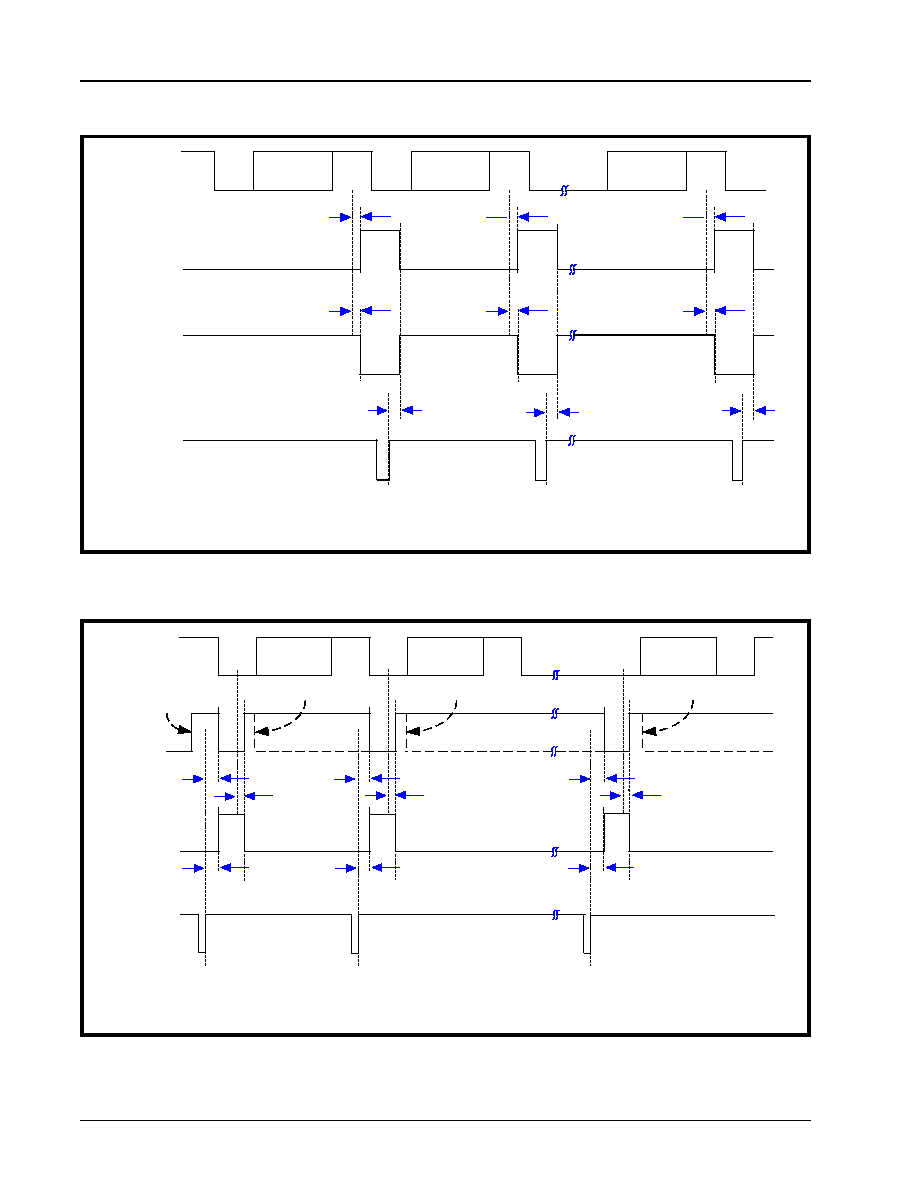
XR16C2850
3.3V AND 5V DUART WITH 128-BYTE FIFO
��
��
��
��
REV. 2.0.0
35
F
IGURE
18. R
ECEIVE
R
EADY
& I
NTERRUPT
T
IMING
[N
ON
-FIFO M
ODE
]
FOR
C
HANNELS
A & B
RX
RXRDY#
IOR#
INT
D0:D7
Start
Bit
D0:D7
Stop
Bit
D0:D7
T
SSR
1 Byte
in RHR
Active
Data
Ready
Active
Data
Ready
Active
Data
Ready
1 Byte
in RHR
1 Byte
in RHR
T
SSR
T
SSR
RXNFM
T
RR
T
RR
T
RR
T
SSR
T
SSR
T
SSR
(Reading data
out of RHR)
F
IGURE
19. T
RANSMIT
R
EADY
& I
NTERRUPT
T
IMING
[N
ON
-FIFO M
ODE
]
FOR
C
HANNELS
A & B
TX
TXRDY#
IOW#
INT*
D0:D7
Start
Bit
D0:D7
Stop
Bit
D0:D7
T
WT
TXNonFIFO
T
WT
T
WT
T
WRI
T
WRI
T
WRI
T
SRT
T
SRT
T
SRT
*INT is cleared when the ISR is read or when data is loaded into the THR.
ISR is read
ISR is read
ISR is read
(Loading data
into THR)
(Unloading)
IER[1]
enabled

��
��
��
��
3.3V AND 5V DUART WITH 128-BYTE FIFO
XR16C2850
REV. 2.0.0
36
F
IGURE
20. R
ECEIVE
R
EADY
& I
NTERRUPT
T
IMING
[FIFO M
ODE
, DMA D
ISABLED
]
FOR
C
HANNELS
A & B
RX
RXRDY#
IOR#
INT
D0:D7
S
T
SSR
RXINTDMA#
RX FIFO fills up to RX
Trigger Level or RX Data
Timeout
RX FIFO drops
below RX
Trigger Level
FIFO
Empties
First Byte is
Received in
RX FIFO
D0:D7
S
D0:D7
T
D0:D7
S
D0:D7
S
T
D0:D7
S
T
T
D0:D7
S
T
Start
Bit
Stop
Bit
T
RR
T
RRI
T
SSI
(Reading data out
of RX FIFO)
F
IGURE
21. R
ECEIVE
R
EADY
& I
NTERRUPT
T
IMING
[FIFO M
ODE
, DMA E
NABLED
]
FOR
C
HANNELS
A & B
RX
RXRDY#
IOR#
INT
D0:D7
S
T
SSR
RXFIFODMA
RX FIFO fills up to RX
Trigger Level or RX Data
Timeout
RX FIFO drops
below RX
Trigger Level
FIFO
Empties
D0:D7
S
D0:D7
T
D0:D7
S
D0:D7
S
T
D0:D7
S
T
T
D0:D7
S
T
Start
Bit
Stop
Bit
T
RR
T
RRI
T
SSI
(Reading data out
of RX FIFO)
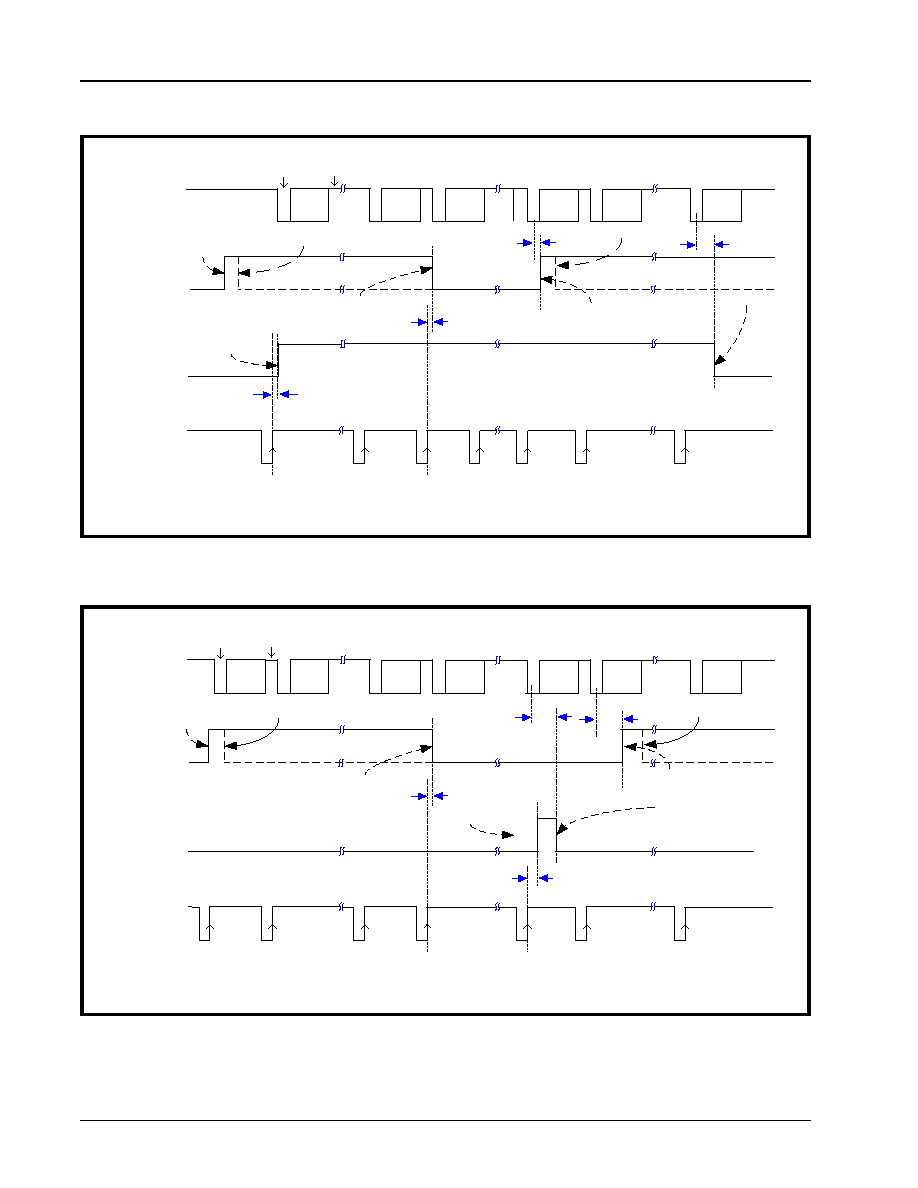
XR16C2850
3.3V AND 5V DUART WITH 128-BYTE FIFO
��
��
��
��
REV. 2.0.0
37
F
IGURE
22. T
RANSMIT
R
EADY
& I
NTERRUPT
T
IMING
[FIFO M
ODE
, DMA M
ODE
D
ISABLED
]
FOR
C
HANNELS
A & B
TX
TXRDY#
IOW#
INT*
TXDMA#
D0:D7
S
D0:D7
T
D0:D7
S
D0:D7
S
T
D0:D7
S
T
T
D0:D7
S
T
Start
Bit
Stop
Bit
T
WRI
(Unloading)
(Loading data
into FIFO)
Last Data Byte
Transmitted
TX FIFO fills up
to trigger level
TX FIFO drops
below trigger level
Data in
TX FIFO
TX FIFO
Empty
T
WT
T
SRT
TX FIFO
Empty
T
T
S
T
SI
ISR is read
IER[1]
enabled
ISR is read
*INT is cleared when the ISR is read or when TX FIFO fills up to the trigger level.
F
IGURE
23. T
RANSMIT
R
EADY
& I
NTERRUPT
T
IMING
[FIFO M
ODE
, DMA M
ODE
E
NABLED
]
FOR
C
HANNELS
A & B
TX
TXRDY#
IOW#
INT*
D0:D7
S
TXDMA
D0:D7
S
D0:D7
T
D0:D7
S
D0:D7
S
T
D0:D7
S
T
T
D0:D7
S
T
Start
Bit
Stop
Bit
T
WRI
T
(Unloading)
(Loading data
into FIFO)
Last Data Byte
Transmitted
TX FIFO fills up
to trigger level
TX FIFO drops
below trigger level
At least 1
empty location
in FIFO
T
SRT
TX FIFO
Full
T
WT
T
SI
ISR Read
ISR Read
*INT cleared when the ISR is read or when TX FIFO fills up to trigger level.
IER[1]
enabled
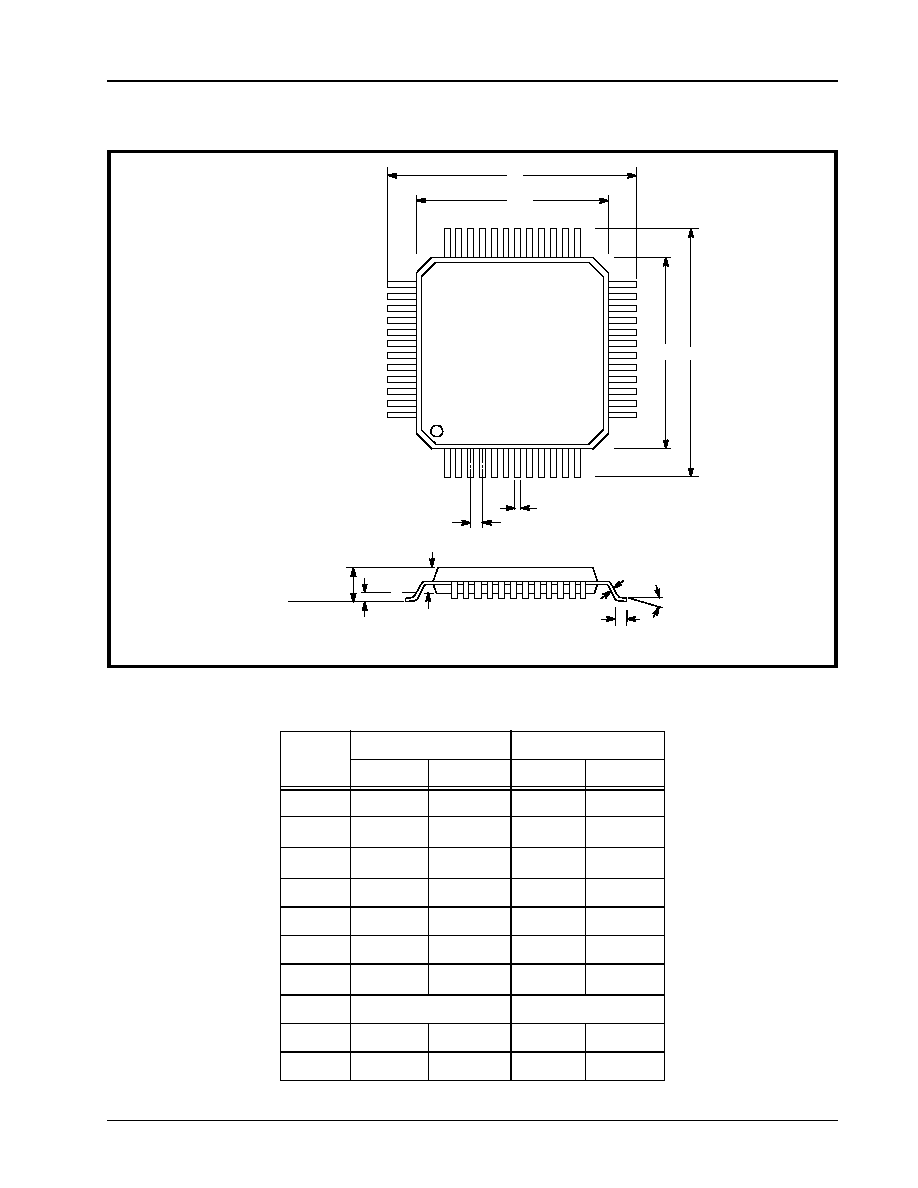
��
��
��
��
3.3V AND 5V DUART WITH 128-BYTE FIFO
XR16C2850
REV. 2.0.0
38
PACKAGE DIMENSIONS (48 PIN TQFP - 7 X 7 X 1
mm
)
36
25
24
13
1
1
2
37
48
D
D
1
D
D
1
B
e
A
2
A
1
A
Seating
Plane
L
C
Note: The control dimension is the millimeter column
INCHES
MILLIMETERS
SYMBOL
MIN
MAX
MIN
MAX
A
0.039
0.047
1.00
1.20
A
1
0.002
0.006
0.05
0.15
A
2
0.037
0.041
0.95
1.05
B
0.007
0.011
0.17
0.27
C
0.004
0.008
0.09
0.20
D
0.346
0.362
8.80
9.20
D
1
0.272
0.280
6.90
7.10
e
0.020 BSC
0.50 BSC
L
0.018
0.030
0.45
0.75
0
�
7
�
0
�
7
�

XR16C2850
3.3V AND 5V DUART WITH 128-BYTE FIFO
��
��
��
��
REV. 2.0.0
39
PACKAGE DIMENSIONS (44 PIN PLCC)
4 4 L E A D P L A S T IC L E A D E D C H IP C A R R IE R
(P L C C )
R e v . 1 .0 0
1
D
D
1
A
A
1
D
D
1
D
3
B
A
2
B
1
e
S e a tin g P la n e
D
2
2
4 4
D
3
C
R
4 5
�
x H
2
4 5
�
x H
1
Note: The control dimension is the millimeter column
INCHES
MILLIMETERS
SYMBOL
MIN
MAX
MIN
MAX
A
0.165
0.180
4.19
4.57
A
1
0.090
0.120
2.29
3.05
A
2
0.020
---
0.51
---
B
0.013
0.021
0.33
0.53
B
1
0.026
0.032
0.66
0.81
C
0.008
0.013
0.19
0.32
D
0.685
0.695
17.40
17.65
D
1
0.650
0.656
16.51
16.66
D
2
0.590
0.630
14.99
16.00
D
3
0.500 typ.
12.70 typ.
e
0.050 BSC
1.27 BSC
H
1
0.042
0.056
1.07
1.42
H
2
0.042
0.048
1.07
1.22
R
0.025
0.045
0.64
1.14

��
��
��
��
3.3V AND 5V DUART WITH 128-BYTE FIFO
XR16C2850
REV. 2.0.0
40
PACKAGE DIMENSIONS (40 PIN PDIP)
4 0
1
2 1
2 0
D
e
A
1
E
1
E
A
L
S e a tin g
P lan e
A
2
B
1
B
C
e
B
e
A
Note: The control dimension is the millimeter column
INCHES
MILLIMETERS
SYMBOL
MIN
MAX
MIN
MAX
A
0.160
0.250
4.06
6.35
A
1
0.015
0.070
0.38
1.78
A
2
0.125
0.195
3.18
4.95
B
0.014
0.024
0.36
0.56
B1
0.030
0.070
0.76
1.78
C
0.008
0.014
0.20
0.38
D
1.98
2.095
50.29
53.21
E
0.600
0.625
15.24
15.88
E
1
0.485
0.580
12.32
14.73
e
0.100 BSC
2.54 BSC
eA
0.600 BSC
15.24 BSC
eB
0.600
0.700
15.24
17.78
L
0.115
0.200
2.92
5.08
0
�
15
�
0
�
15
�

���
���
���
���
3.3V AND 5V DUART WITH 128-BYTE FIFO
XR16C2850
REV. 2.0.0
41
NOTICE
EXAR Corporation reserves the right to make changes to the products contained in this publication in order
to improve design, performance or reliability. EXAR Corporation assumes no responsibility for the use of
any circuits described herein, conveys no license under any patent or other right, and makes no represen-
tation that the circuits are free of patent infringement. Charts and schedules contained here in are only for
illustration purposes and may vary depending upon a user's specific application. While the information in
this publication has been carefully checked; no responsibility, however, is assumed for inaccuracies.
EXAR Corporation does not recommend the use of any of its products in life support applications where
the failure or malfunction of the product can reasonably be expected to cause failure of the life support sys-
tem or to significantly affect its safety or effectiveness. Products are not authorized for use in such applica-
tions unless EXAR Corporation receives, in writing, assurances to its satisfaction that: (a) the risk of injury
or damage has been minimized; (b) the user assumes all such risks; (c) potential liability of EXAR Corpo-
ration is adequately protected under the circumstances.
Copyright 2002 EXAR Corporation
Datasheet April 2002
Send your UART technical inquiry with technical details to hotline:
uarttechsupport@exar.com
Reproduction, in part or whole, without the prior written consent of EXAR Corporation is prohibited.
REVISION HISTORY
Date
Revision
Description
February 2000
Rev 1.0.0
Initial datasheet.
April 2002
Rev 2.0.0
Changed to standard style format. Internal Registers are described in the order
they are listed in the Internal Register Table. Clarified timing diagrams. Cor-
rected Auto RTS Hysteresis table. Renamed Rclk (Receive Clock) to Bclk (Baud
Clock) and timing symbols. Added T
AH
, T
CS
and OSC.

��
��
��
��
XR16C2850
3.3V AND 5V DUART WITH 128-BYTE FIFO
REV. 2.0.0
I
TABLE OF CONTENTS
GENERAL DESCRIPTION................................................................................................. 1
A
PPLICATIONS
............................................................................................................................................. 1
F
EATURES
.................................................................................................................................................. 1
F
IGURE
1. XR16C2850 B
LOCK
D
IAGRAM
................................................................................................................................................ 1
F
IGURE
2. P
IN
O
UT
A
SSIGNMENT
............................................................................................................................................................. 2
ORDERING
INFORMATION
............................................................................................................................. 2
PIN DESCRIPTIONS .......................................................................................................... 3
DATA BUS INTERFACE........................................................................................................................... 3
MODEM OR SERIAL I/O INTERFACE ..................................................................................................... 3
ANCILLARY SIGNALS.............................................................................................................................. 4
1.0 Product DESCRIPTION ........................................................................................................... 6
2.0 FUNCTIONAL DESCRIPTIONS ............................................................................................... 7
2.1 CPU I
NTERFACE
................................................................................................................................. 7
F
IGURE
3. XR16C2850 D
ATA
B
US
I
NTERCONNECTIONS
......................................................................................................................... 7
2.2 D
EVICE
R
ESET
.................................................................................................................................... 7
2.3 D
EVICE
I
DENTIFICATION
AND
R
EVISION
................................................................................................ 7
2.4 C
HANNEL
A
AND
B S
ELECTION
............................................................................................................ 7
T
ABLE
1: C
HANNEL
A
AND
B S
ELECT
....................................................................................................................................................... 7
2.5 C
HANNEL
A
AND
B I
NTERNAL
R
EGISTERS
............................................................................................ 8
2.6 DMA M
ODE
........................................................................................................................................ 8
T
ABLE
2: TXRDY#
AND
RXRDY# O
UTPUTS
IN
FIFO
AND
DMA M
ODE
.................................................................................................... 8
2.7 INTA
AND
INTB O
UPUTS
.................................................................................................................... 8
T
ABLE
3: INTA
AND
INTB P
INS
O
PERATION
FOR
T
RANSMITTER
................................................................................................................ 8
2.8 C
RYSTAL
O
SCILLATOR
OR
E
XT
. C
LOCK
I
NPUT
...................................................................................... 9
T
ABLE
4: INTA
AND
INTB P
IN
O
PERATION
F
OR
R
ECEIVER
....................................................................................................................... 9
F
IGURE
4. T
YPICAL
OSCILLATOR
CONNECTIONS
........................................................................................................................................ 9
2.9 P
ROGRAMMABLE
B
AUD
R
ATE
G
ENERATOR
........................................................................................... 9
F
IGURE
5. E
XTERNAL
C
LOCK
C
ONNECTION
FOR
E
XTENDED
D
ATA
R
ATE
................................................................................................... 9
F
IGURE
6. B
AUD
R
ATE
G
ENERATOR
AND
P
RESCALER
............................................................................................................................ 10
T
ABLE
5: T
YPICAL
DATA
RATES
WITH
A
14.7456 MH
Z
CRYSTAL
OR
EXTERNAL
CLOCK
.............................................................................. 10
2.10 T
RANSMITTER
................................................................................................................................. 11
2.10.1 Transmit Holding Register (THR) - Write Only ....................................................................................... 11
2.10.2 Transmitter Operation in non-FIFO Mode .............................................................................................. 11
F
IGURE
7. T
RANSMITTER
O
PERATION
IN
NON
-FIFO M
ODE
...................................................................................................................... 11
2.10.3 Transmitter Operation in FIFO Mode ..................................................................................................... 11
F
IGURE
8. T
RANSMITTER
O
PERATION
IN
FIFO
AND
F
LOW
C
ONTROL
M
ODE
............................................................................................. 11
2.11 R
ECEIVER
....................................................................................................................................... 12
2.11.1 Receive Holding Register (RHR) - Read-Only ....................................................................................... 12
F
IGURE
9. R
ECEIVER
O
PERATION
IN
NON
-FIFO M
ODE
........................................................................................................................... 12
F
IGURE
10. R
ECEIVER
O
PERATION
IN
FIFO
AND
A
UTO
RTS F
LOW
C
ONTROL
M
ODE
............................................................................... 13
2.12 A
UTO
RTS (H
ARDWARE
) F
LOW
C
ONTROL
....................................................................................... 13
2.13 A
UTO
RTS H
YSTERESIS
................................................................................................................. 13
2.14 A
UTO
CTS F
LOW
C
ONTROL
........................................................................................................... 13
F
IGURE
11. A
UTO
RTS
AND
CTS F
LOW
C
ONTROL
O
PERATION
.............................................................................................................. 14
2.15 A
UTO
X
ON
/X
OFF
(S
OFTWARE
) F
LOW
C
ONTROL
............................................................................... 14
T
ABLE
6: A
UTO
X
ON
/X
OFF
(S
OFTWARE
) F
LOW
C
ONTROL
....................................................................................................................... 15
2.16 S
PECIAL
C
HARACTER
D
ETECT
........................................................................................................ 15
2.17 A
UTO
RS485 H
ALF
-
DUPLEX
C
ONTROL
........................................................................................... 15
2.18 I
NFRARED
M
ODE
............................................................................................................................. 15
F
IGURE
12. I
NFRARED
T
RANSMIT
D
ATA
E
NCODING
AND
R
ECEIVE
D
ATA
D
ECODING
................................................................................. 16
2.19 S
LEEP
M
ODE
WITH
A
UTO
W
AKE
-U
P
............................................................................................... 16
2.20 I
NTERNAL
L
OOPBACK
..................................................................................................................... 16
F
IGURE
13. I
NTERNAL
L
OOP
B
ACK
IN
C
HANNEL
A
AND
B........................................................................................................................ 17
3.0 UART INTERNAL REGISTERS ............................................................................................. 18
T
ABLE
7: UART CHANNEL A AND B UART INTERNAL REGISTERS ............................................................................................. 18

XR16C2850
��
��
��
��
3.3V AND 5V DUART WITH 128-BYTE FIFO
REV. 2.0.0
II
T
ABLE
8: INTERNAL REGISTERS DESCRIPTION. S
HADED
BITS
ARE
ENABLED
WHEN
EFR B
IT
-4=1 ................................................ 19
4.0 INTERNAL Register descriptions ........................................................................................ 20
4.1 R
ECEIVE
H
OLDING
R
EGISTER
(RHR) - R
EAD
- O
NLY
........................................................................... 20
4.2 T
RANSMIT
H
OLDING
R
EGISTER
(THR) - W
RITE
-O
NLY
......................................................................... 20
4.3 I
NTERRUPT
E
NABLE
R
EGISTER
(IER) - R
EAD
/W
RITE
........................................................................... 20
4.3.1 IER versus Receive FIFO Interrupt Mode Operation................................................................................ 20
4.3.2 IER versus Receive/Transmit FIFO Polled Mode Operation .................................................................... 20
4.4 I
NTERRUPT
S
TATUS
R
EGISTER
(ISR) - R
EAD
-O
NLY
............................................................................ 21
4.4.1 Interrupt Generation: ................................................................................................................................ 21
4.4.2 Interrupt Clearing:..................................................................................................................................... 22
T
ABLE
9: I
NTERRUPT
S
OURCE
AND
P
RIORITY
L
EVEL
............................................................................................................................... 22
4.5 FIFO C
ONTROL
R
EGISTER
(FCR) - W
RITE
-O
NLY
............................................................................... 22
T
ABLE
10: T
RANSMIT
AND
R
ECEIVE
FIFO T
RIGGER
L
EVEL
S
ELECTION
.................................................................................................... 23
4.6 L
INE
C
ONTROL
R
EGISTER
(LCR) - R
EAD
/W
RITE
................................................................................. 24
4.7 M
ODEM
C
ONTROL
R
EGISTER
(MCR)
OR
G
ENERAL
P
URPOSE
O
UTPUTS
C
ONTROL
- R
EAD
/W
RITE
........ 24
T
ABLE
11: P
ARITY
SELECTION
................................................................................................................................................................ 24
4.8 L
INE
S
TATUS
R
EGISTER
(LSR) - R
EAD
O
NLY
..................................................................................... 25
4.9 M
ODEM
S
TATUS
R
EGISTER
(MSR) - R
EAD
O
NLY
............................................................................... 26
4.10 S
CRATCH
P
AD
R
EGISTER
(SPR) - R
EAD
/W
RITE
............................................................................... 26
4.11 E
NHANCED
M
ODE
S
ELECT
R
EGISTER
(EMSR) ................................................................................. 27
T
ABLE
12: S
CRATCHPAD
S
WAP
S
ELECTION
............................................................................................................................................ 27
T
ABLE
13: A
UTO
RTS H
YSTERESIS
....................................................................................................................................................... 27
4.12 FIFO L
EVEL
R
EGISTER
(FLVL) - R
EAD
-O
NLY
................................................................................... 27
4.13 B
AUD
R
ATE
G
ENERATOR
R
EGISTERS
(DLL
AND
DLM) - R
EAD
/W
RITE
............................................... 27
4.14 D
EVICE
I
DENTIFICATION
R
EGISTER
(DVID) - R
EAD
O
NLY
.................................................................. 27
4.15 D
EVICE
R
EVISION
R
EGISTER
(DREV) - R
EAD
O
NLY
......................................................................... 27
4.16 T
RIGGER
L
EVEL
/ FIFO D
ATA
C
OUNT
R
EGISTER
(TRG) - W
RITE
-O
NLY
............................................. 27
4.17 FIFO D
ATA
C
OUNT
R
EGISTER
(FC) - R
EAD
-O
NLY
............................................................................ 27
4.18 F
EATURE
C
ONTROL
R
EGISTER
(FCTR) - R
EAD
/W
RITE
.................................................................... 28
T
ABLE
14: T
RIGGER
T
ABLE
S
ELECT
....................................................................................................................................................... 28
4.19 E
NHANCED
F
EATURE
R
EGISTER
(EFR) ............................................................................................ 28
T
ABLE
15: S
OFTWARE
F
LOW
C
ONTROL
F
UNCTIONS
............................................................................................................................... 29
4.20 S
OFTWARE
F
LOW
C
ONTROL
R
EGISTERS
(XOFF1, XOFF2, XON1, XON2) - R
EAD
/W
RITE
............... 30
T
ABLE
16: UART RESET CONDITIONS FOR CHANNEL A AND B ................................................................................................... 30
ABSOLUTE MAXIMUM RATINGS...................................................................................31
TYPICAL PACKAGE THERMAL RESISTANCE DATA (MARGIN OF ERROR: � 15%) 31
ELECTRICAL CHARACTERISTICS ................................................................................31
DC E
LECTRICAL
C
HARACTERISTICS
...........................................................................................................31
AC E
LECTRICAL
C
HARACTERISTICS
............................................................................................................32
TA=0
O
TO
70
O
C (-40
O
TO
+85
O
C
FOR
INDUSTRIAL
GRADE
PACKAGE
), V
CC
IS
3.3
OR
5.0V �10% .............32
F
IGURE
14. C
LOCK
T
IMING
.................................................................................................................................................................... 33
F
IGURE
15. M
ODEM
I
NPUT
/O
UTPUT
T
IMING
F
OR
C
HANNELS
A & B......................................................................................................... 33
F
IGURE
16. D
ATA
B
US
R
EAD
T
IMING
..................................................................................................................................................... 34
F
IGURE
17. D
ATA
B
US
W
RITE
T
IMING
.................................................................................................................................................... 34
F
IGURE
18. R
ECEIVE
R
EADY
& I
NTERRUPT
T
IMING
[N
ON
-FIFO M
ODE
]
FOR
C
HANNELS
A & B................................................................. 35
F
IGURE
19. T
RANSMIT
R
EADY
& I
NTERRUPT
T
IMING
[N
ON
-FIFO M
ODE
]
FOR
C
HANNELS
A & B............................................................... 35
F
IGURE
20. R
ECEIVE
R
EADY
& I
NTERRUPT
T
IMING
[FIFO M
ODE
, DMA D
ISABLED
]
FOR
C
HANNELS
A & B ............................................... 36
F
IGURE
21. R
ECEIVE
R
EADY
& I
NTERRUPT
T
IMING
[FIFO M
ODE
, DMA E
NABLED
]
FOR
C
HANNELS
A & B ................................................ 36
F
IGURE
22. T
RANSMIT
R
EADY
& I
NTERRUPT
T
IMING
[FIFO M
ODE
, DMA M
ODE
D
ISABLED
]
FOR
C
HANNELS
A & B ................................... 37
F
IGURE
23. T
RANSMIT
R
EADY
& I
NTERRUPT
T
IMING
[FIFO M
ODE
, DMA M
ODE
E
NABLED
]
FOR
C
HANNELS
A & B .................................... 37
PACKAGE DIMENSIONS (48 PIN TQFP - 7 X 7 X 1 MM)...............................................38
PACKAGE DIMENSIONS (44 PIN PLCC) .......................................................................39
PACKAGE DIMENSIONS (40 PIN PDIP).........................................................................40
R
EVISION
H
ISTORY
....................................................................................................................................41
TABLE OF CONTENTS ................................................................................................................................. I










































